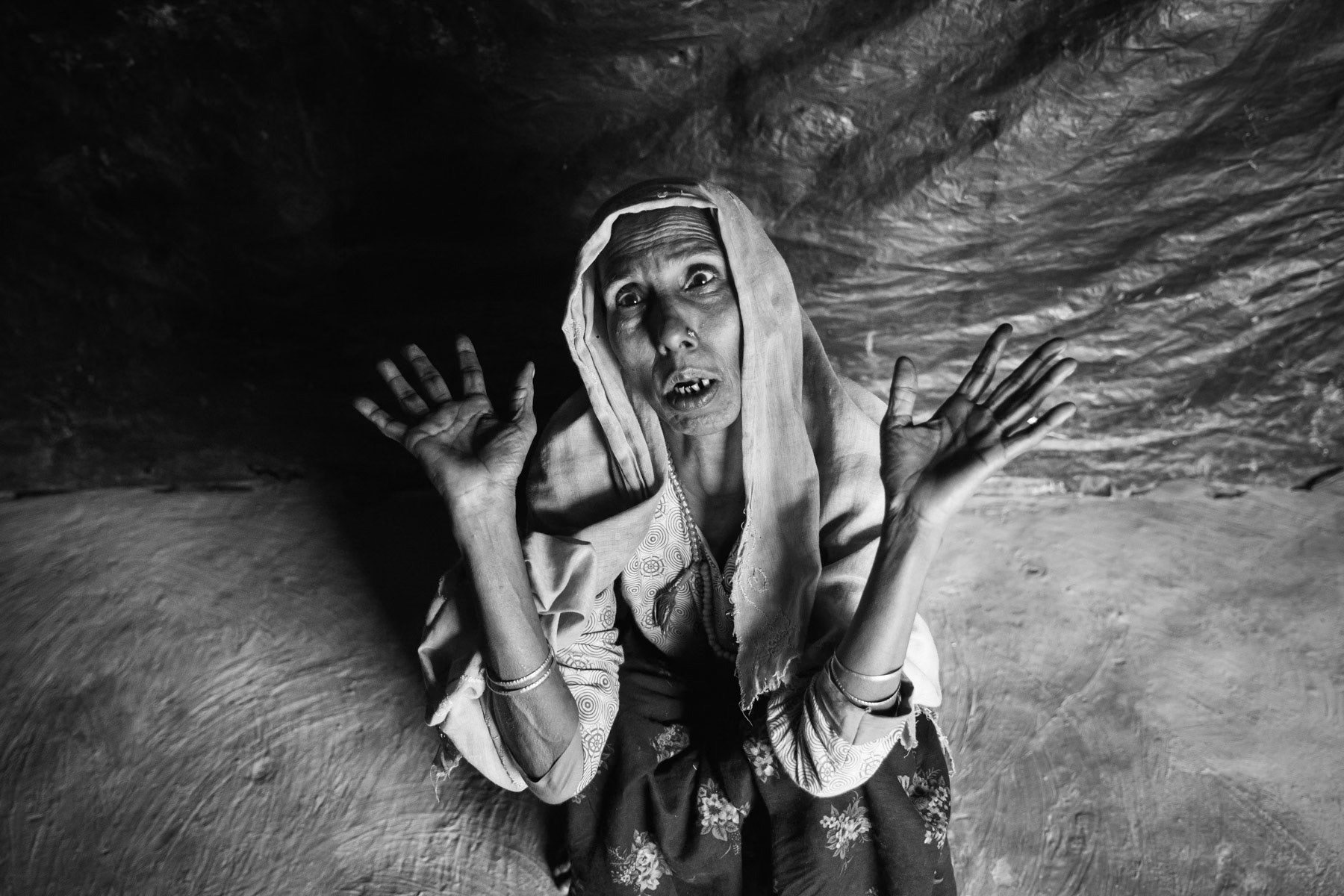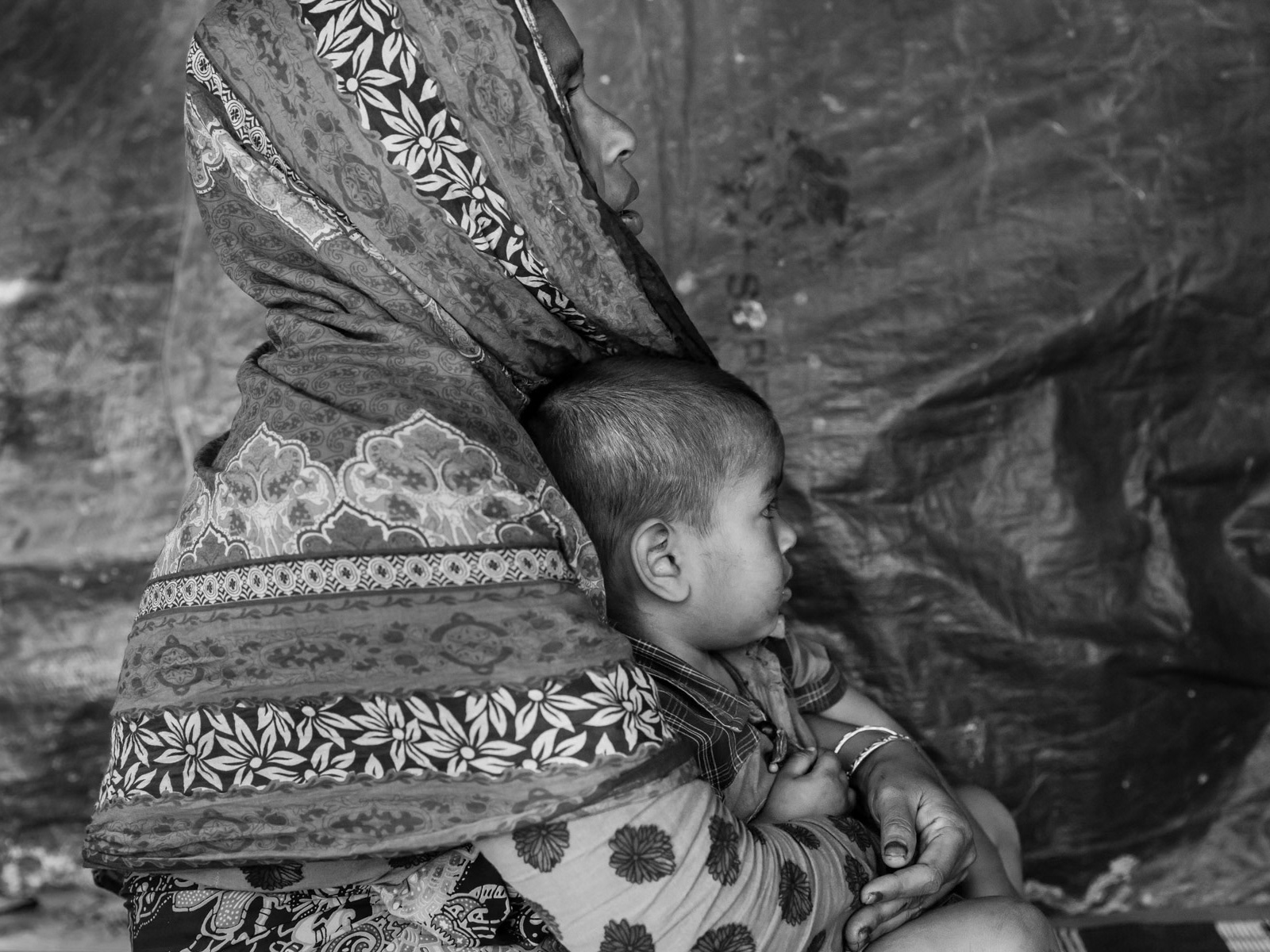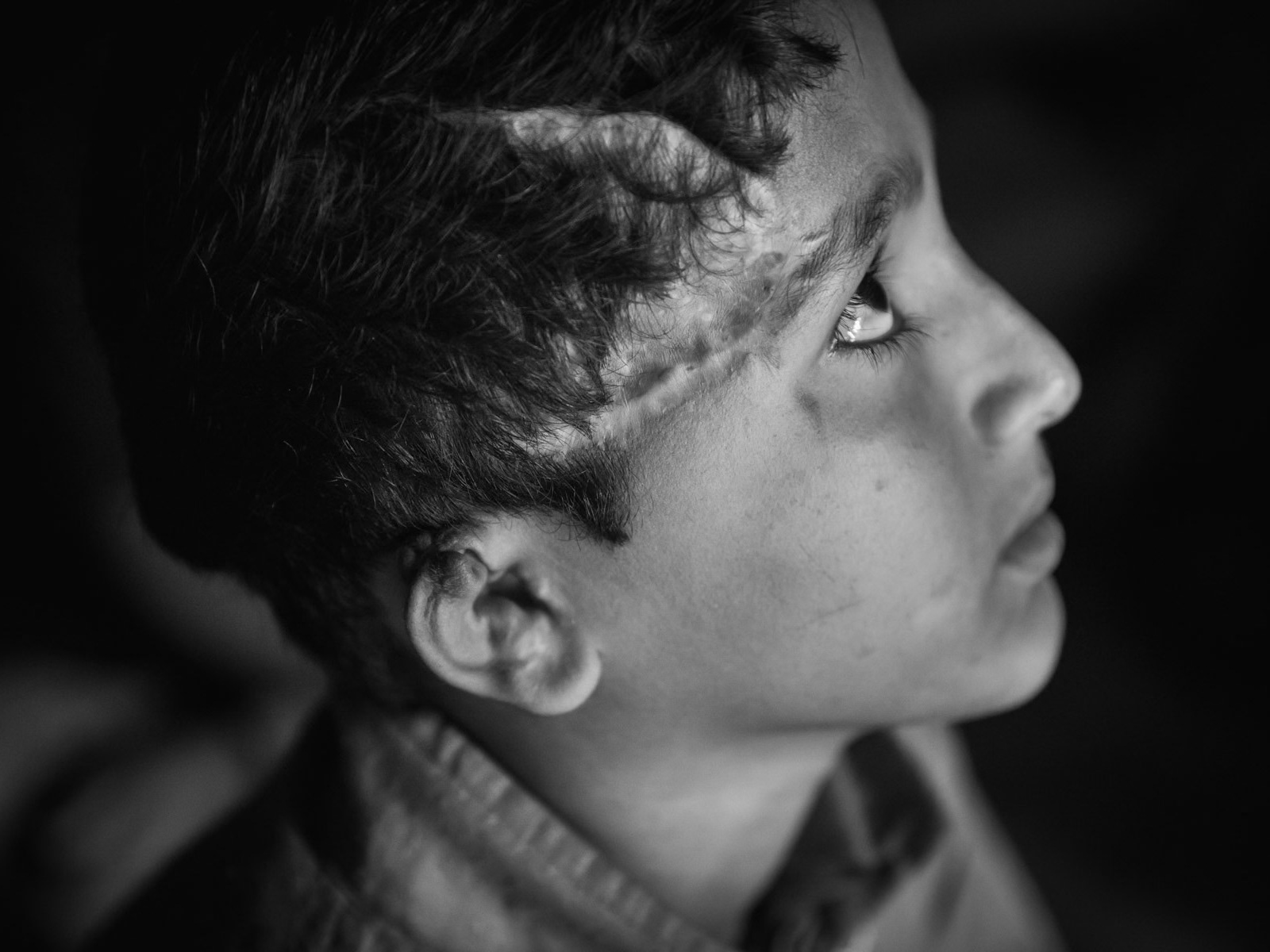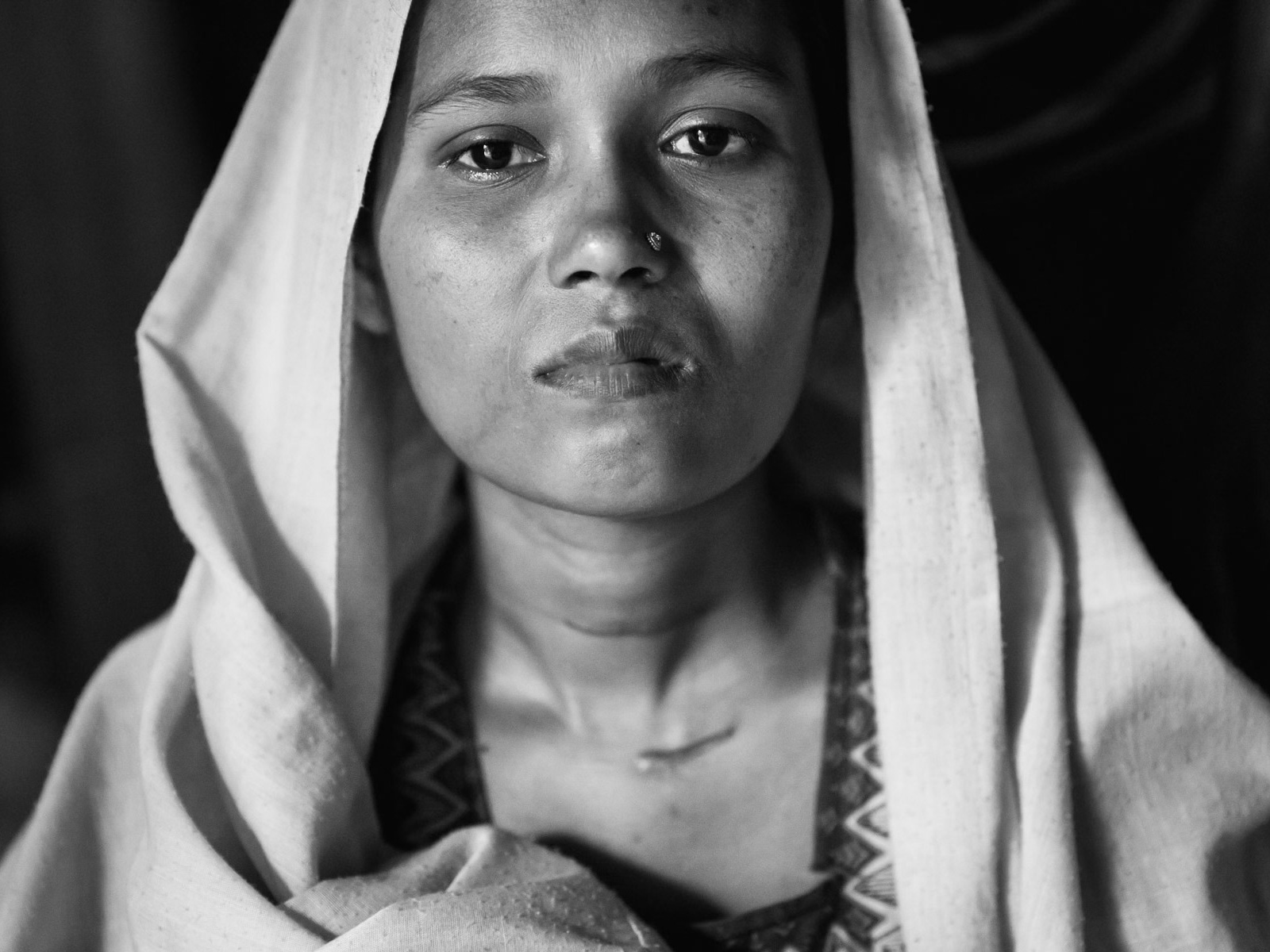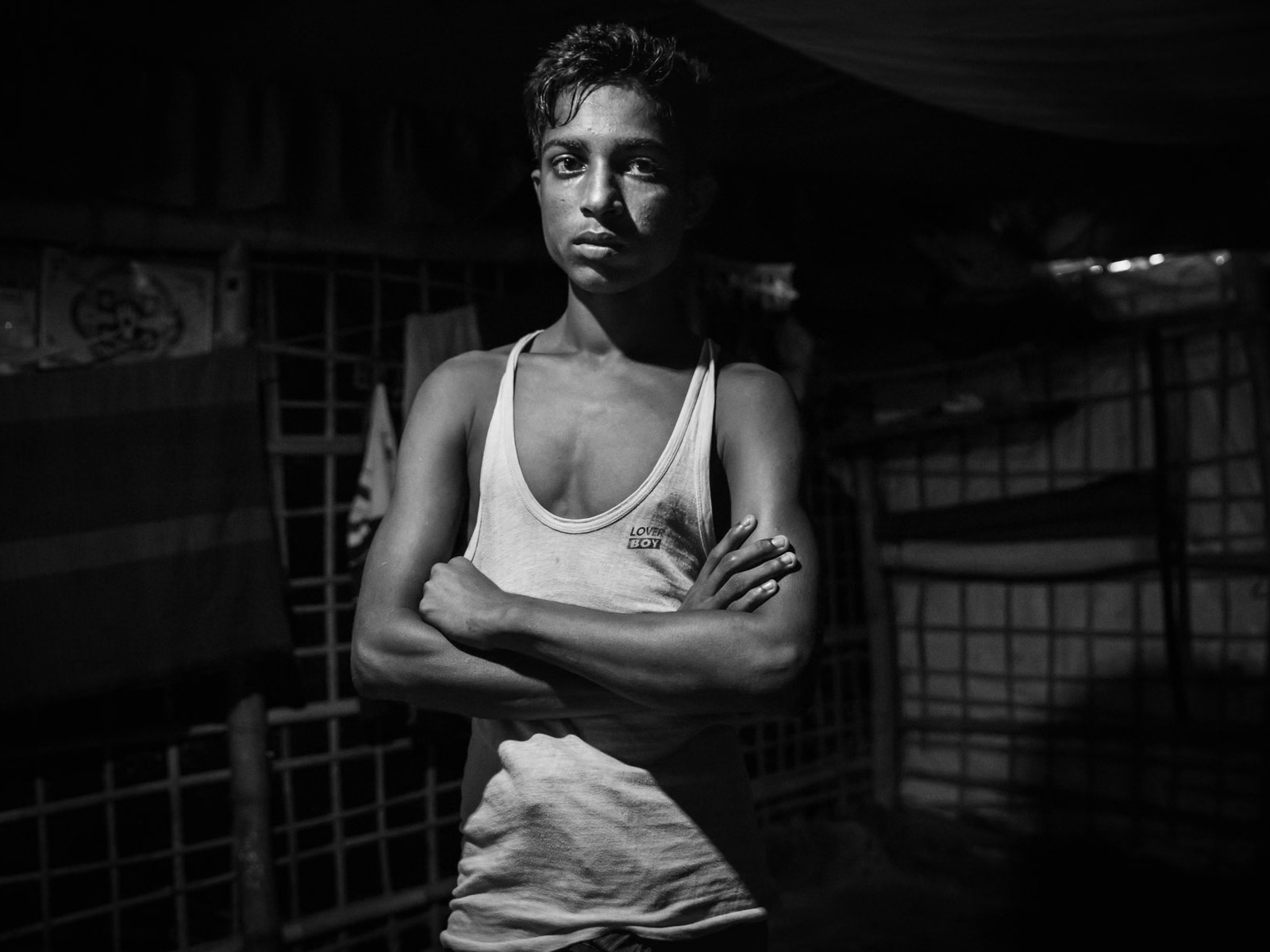Between 2016 and 2017, the Rohingya, a Muslim minority group in Myanmar's Rakhine State, faced extreme persecution, leading many observers to label the violence as ethnic cleansing or even genocide. In response to attacks on security posts by Rohingya militants, Myanmar's military carried out brutal operations targeting civilians, involving mass killings, torture, and sexual violence. Entire villages were destroyed, and families were displaced, with the military's actions resembling signs of genocide as outlined by the United Nations Genocide Convention. Women and girls were particularly subjected to horrific sexual violence, which was used as a weapon of war. Babies and children were killed, and many survivors were left with severe physical and psychological trauma.
The international community has condemned these actions, and in 2019, the International Court of Justice (ICJ) ruled that Myanmar must take steps to prevent further genocide and preserve evidence. However, the political challenges of holding Myanmar accountable have hindered meaningful action. As a result, hundreds of thousands of Rohingya fled to Bangladesh, facing dire conditions in overcrowded refugee camps. Despite humanitarian efforts, refugees continue to suffer from inadequate shelter, sanitation, and healthcare. Many survivors are emotionally scarred, and repatriation remains uncertain, leaving the Rohingya in a prolonged state of displacement and fear.
The ongoing crisis highlights the failure of the international community to prevent genocide and protect vulnerable populations, leaving the Rohingya with little hope for justice or a better future.
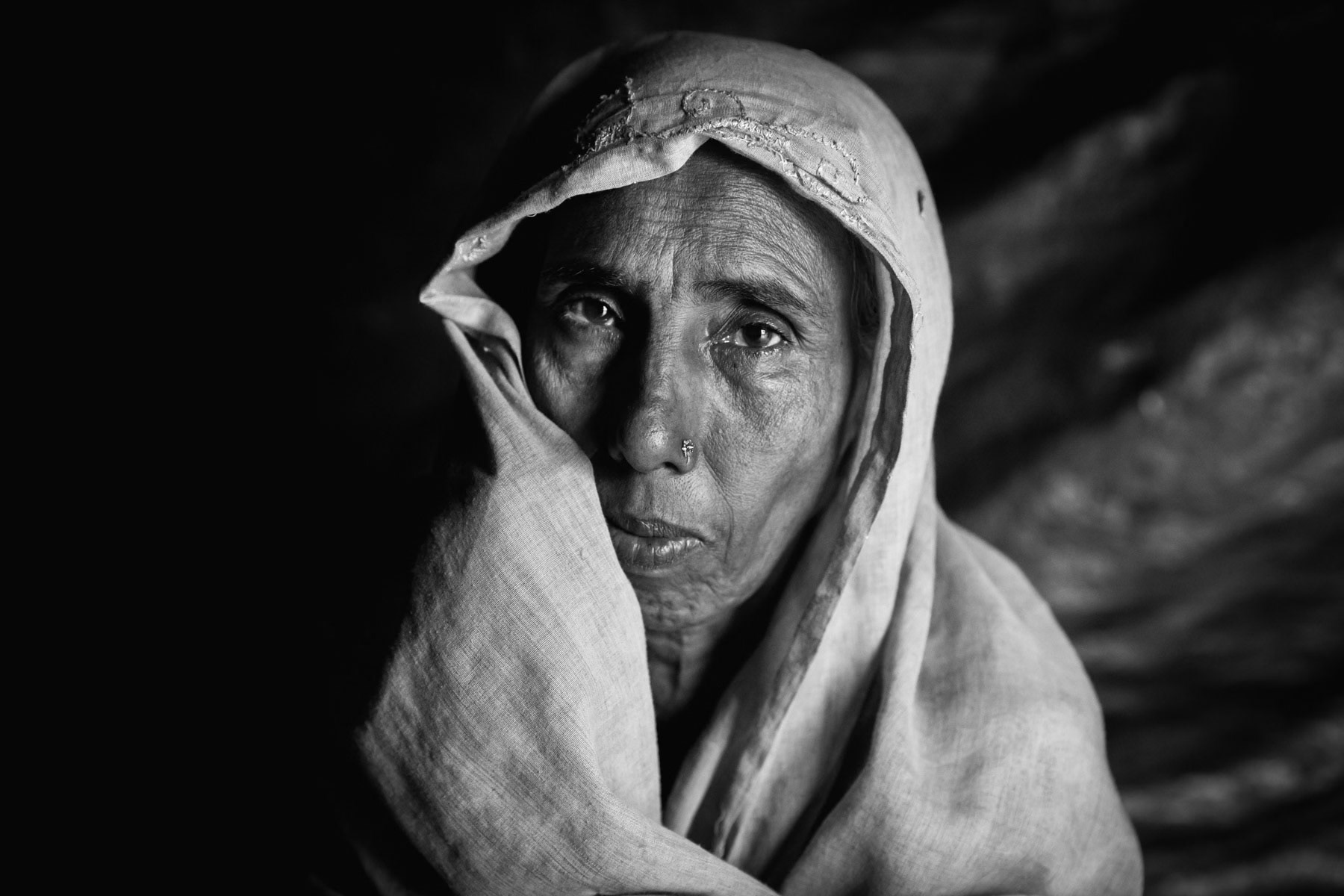
Nurashah Khatun, 60 years old Rohingya refugee from Maungdaw township in Myanmar. Her village was attacked in August 2017, she reached Bangladesh after 2 days walking. She lost track of her husband and 17 year old daughter, they have been missing ever since. She lives in Balukhali refugee camp with her 4 surviving daughters ever since. Human rights organisations have stated that thousands of Rohingya have been killed and missing ever since the military operations in Northern. Thousands of girls and women have been tortured and systematically raped in a situation that has evolved from ethnic cleansing to genocide. Balukhali camp for Rohingya refugees, Bangladesh, October 2018
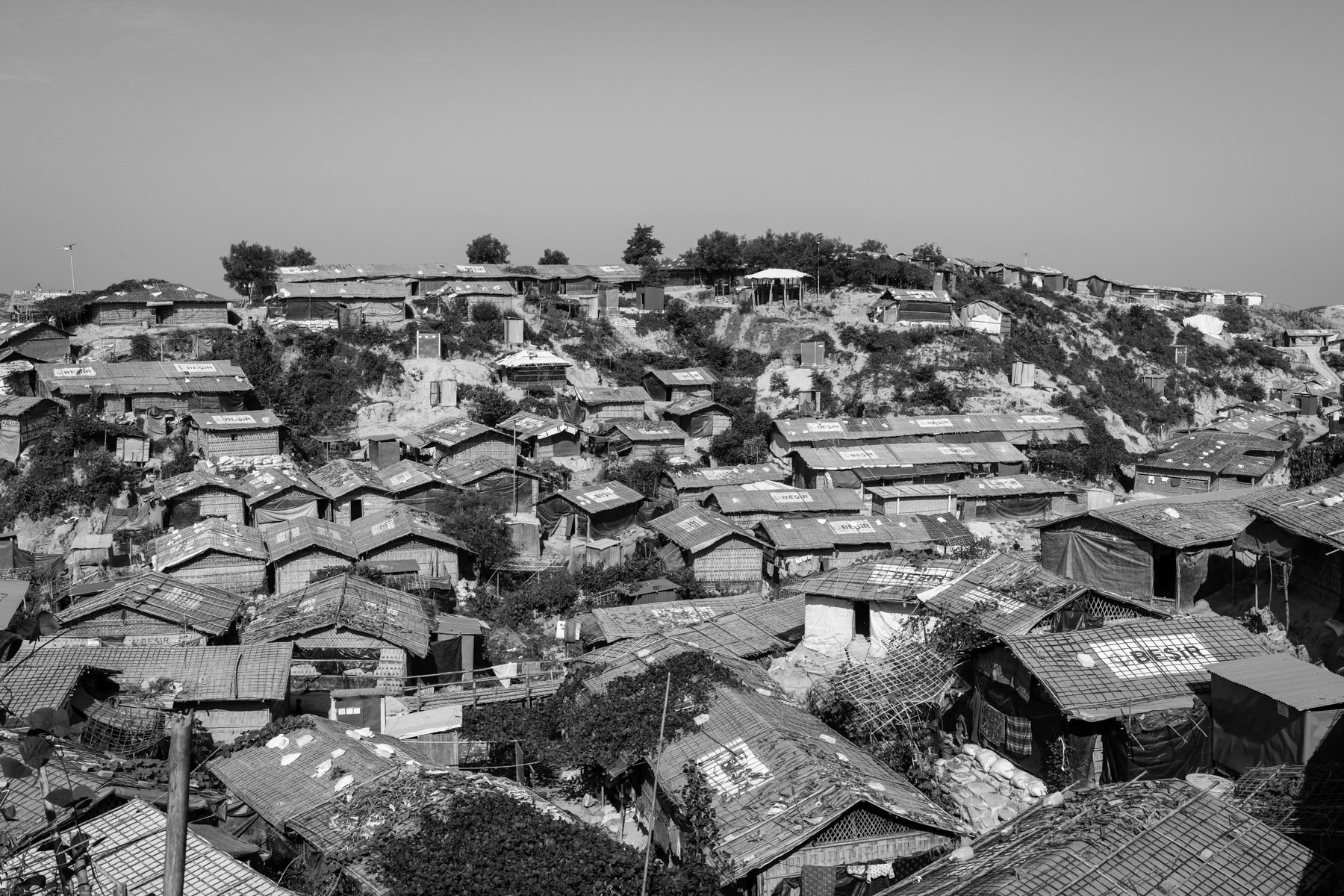
A new extension to the already overcrowded refugee camps to shelter part of the 650,000 newly arrived Rohingya refugees. The Rohingya refugee camps are now sheltering Rohingya victims of the 1978, 1992, 2008, 2012, 2016 and 2017 ethnic cleansing campaigns. By end 2018 more than one million Rohingya refugees live in the camps near Cox's Bazar making it the largest refugee camps in the world. Thangkhali section, Ukhiya, Bangladesh, October 2018
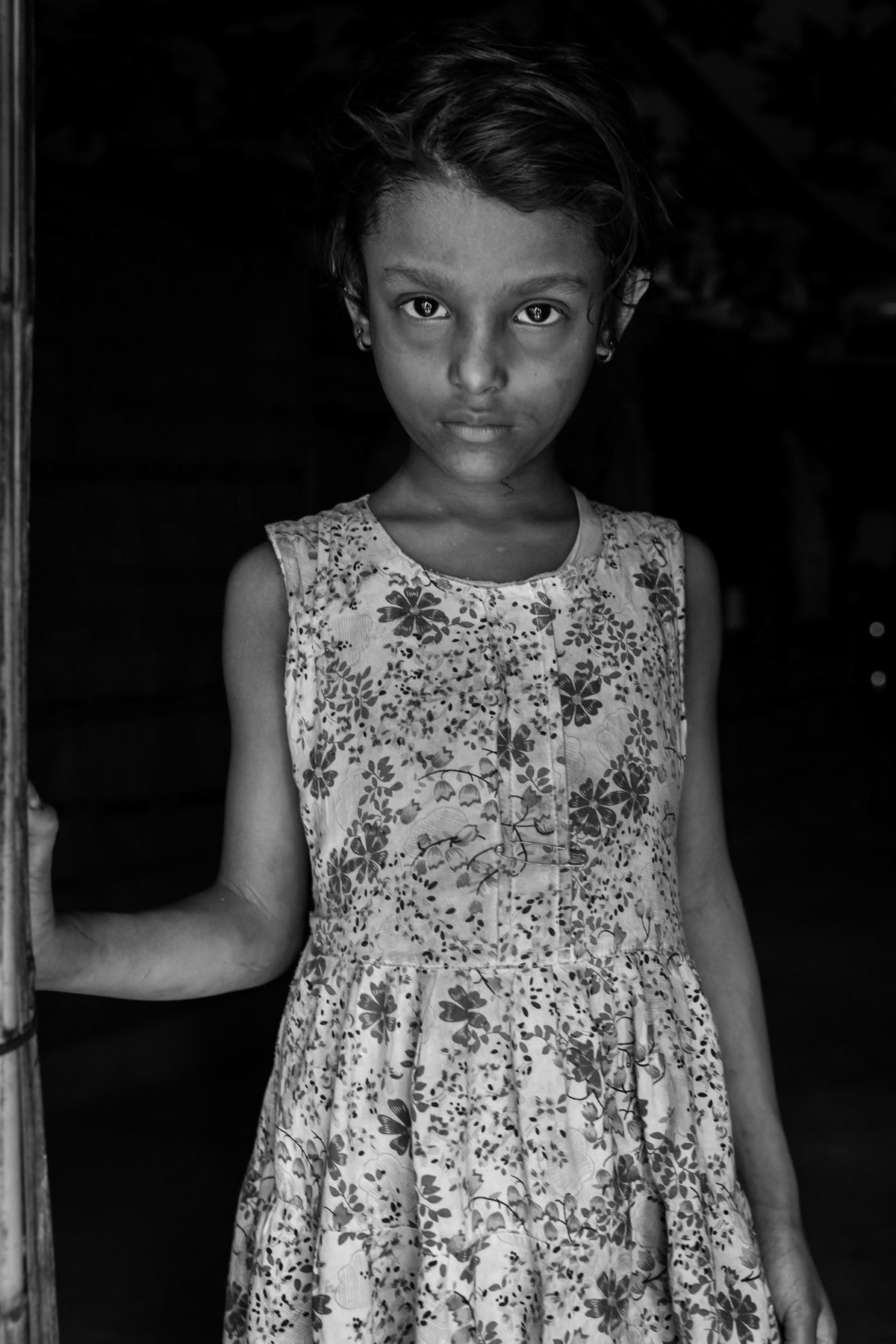
I met Azida, a Rohingya child, back in November 2017 when she was dying of battery acid poisening, acid that was forcibly given to her by military and Rakhine mobs. She is now looking much better and gained weight. She can now eat more diverse food but in very small quantities otherwise she still has frequently vomits and her digestive system is still very fragile. Balukhali refugee camp for Rohingya refugees, Bangladesh, October 2018
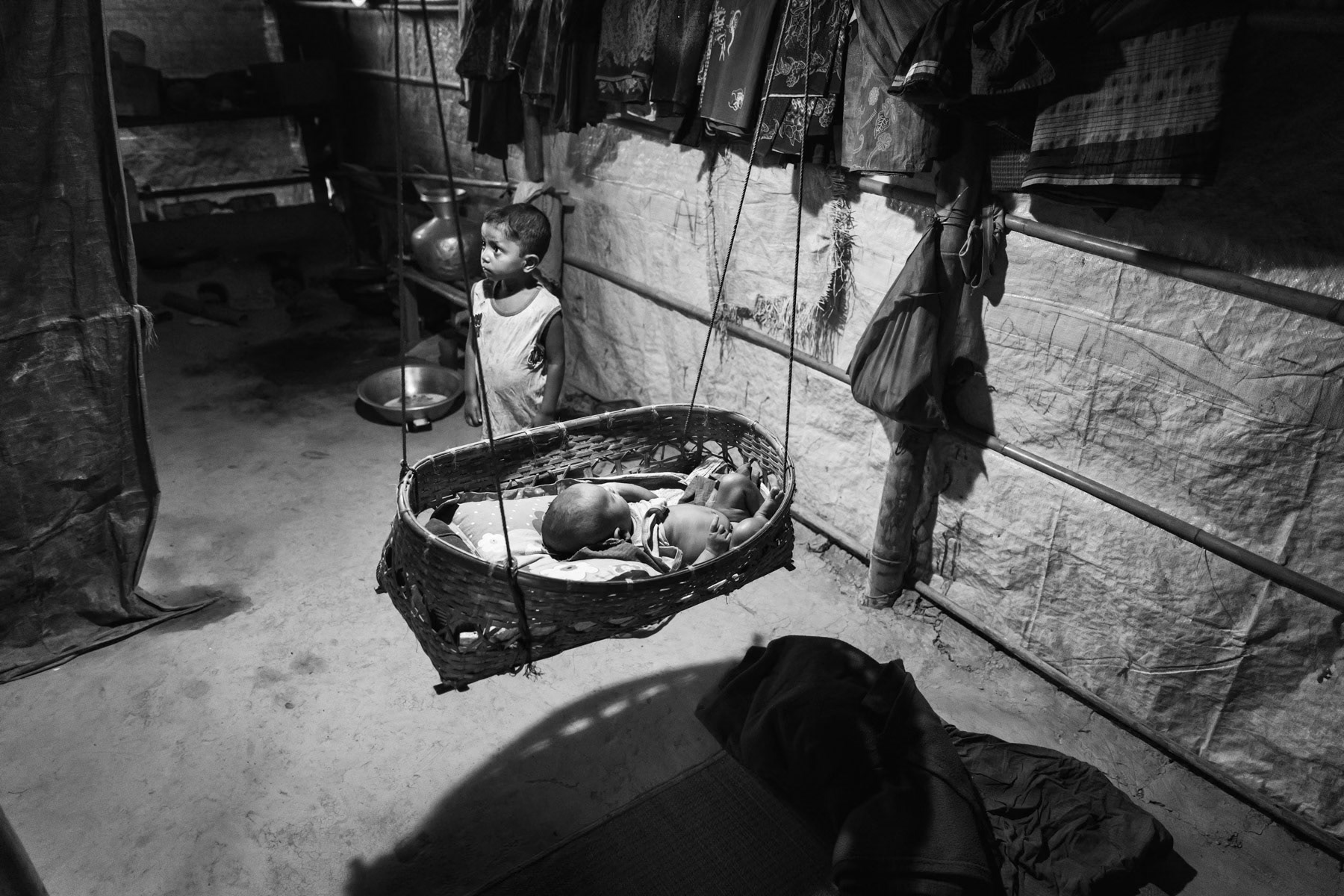
Moria Khatun's first son and her new born son from Maungdaw township in Myanmar. His mother was tortured, blindfolded, tightened and gang raped for 4 hours by military and local Rakhine. After the military left the village, her husband who was hiding in the jungle, came to evacuate them. Nuru Hafez the little baby boy was born in June 2018 nine months after his mother had been raped. Balukhali refugee camp in Bangladesh, October 2018
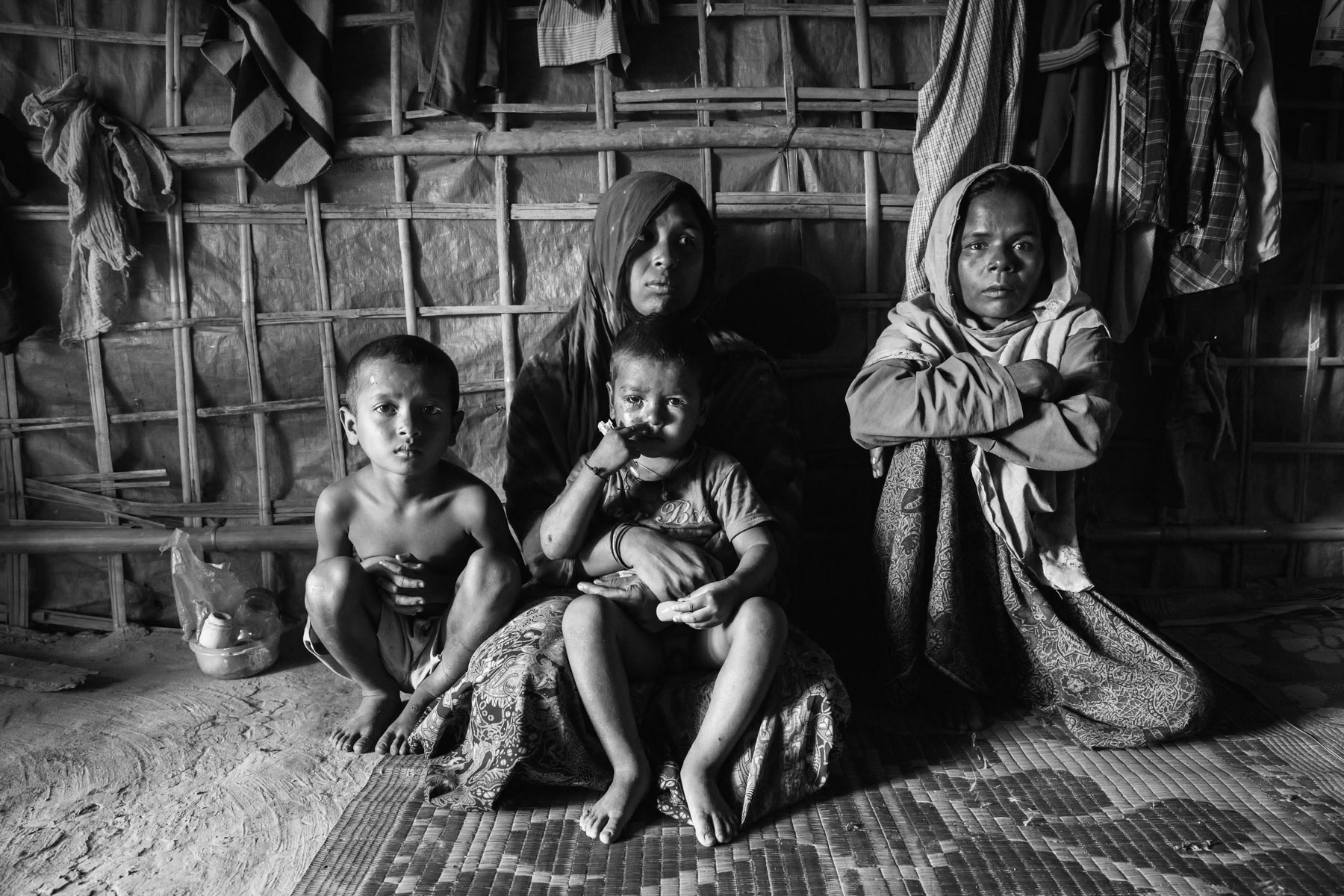
Subiya Khatun (left) and Nasima Khatun (right) from Chut Pyin near Rathedaung, Myanmar. Subiya is 35 years, her daughter of 15 was raped and consequently killed during the attack on their village by Myanmar military and local Rakhine mobs. Her husband was decapitated and 2 sons of 12 and 13 years were also killed in cold blood. She has one son who fled to Malaysia by boat in 2015 when he was 16 years. She hasn't received any phone call from him since March 2017 and has lost all track of him. Subiya is living with her 4 surviving young children in Bangladesh since Septamber 2017. Nasima is 37 years, her husband, her daughter of 12 and two sons of 18 and 19 were massacred by the military during the attack on the village in August 2017. In Myanmar they were farmers owning considerable large plots of land. Nasima survives now in the refugee camps with her 5 remaining children, the youngest one being born few weeks before the attack. Thangkhali Rohingya refugee camp in Bangladesh, October 2018
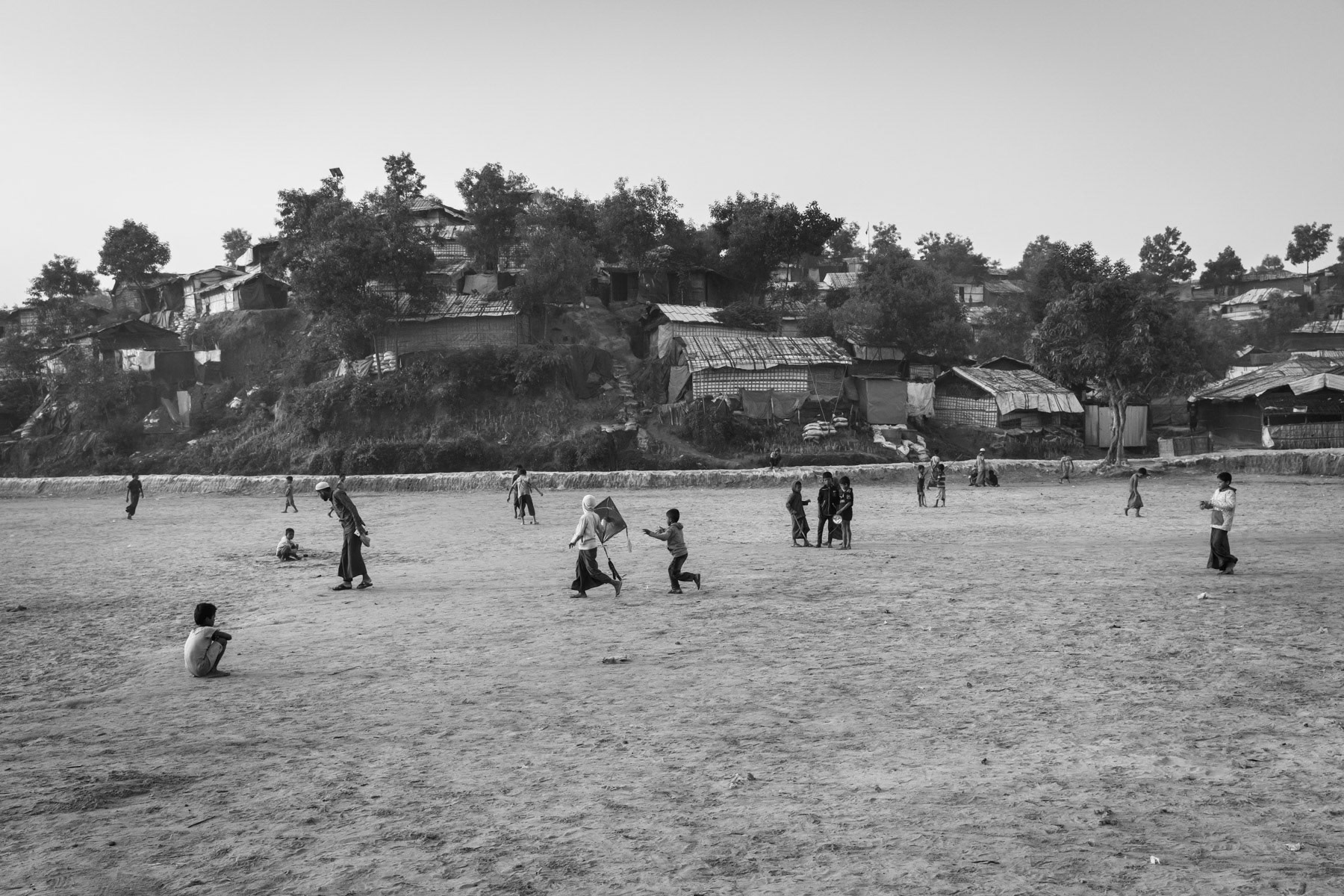
One of the few open spaces where children can still play. Thangkhali camp for Rohingya refugees in Southern Bangladesh, October 2018

Hasina, 37, a Rohingya refugee from a village near Maungdaw in Myanmar. Her village was attacked by the Myanmar military during the first so called security operations in October 2016. During the attack her husband and two sons of 9 and 13 years were massacred. She arrived with her 4 surviving children in Bangladesh in October 2016. Rohingya refugee camp Kutupalong section II, Cox's Bazar, Bangladesh, October 2018
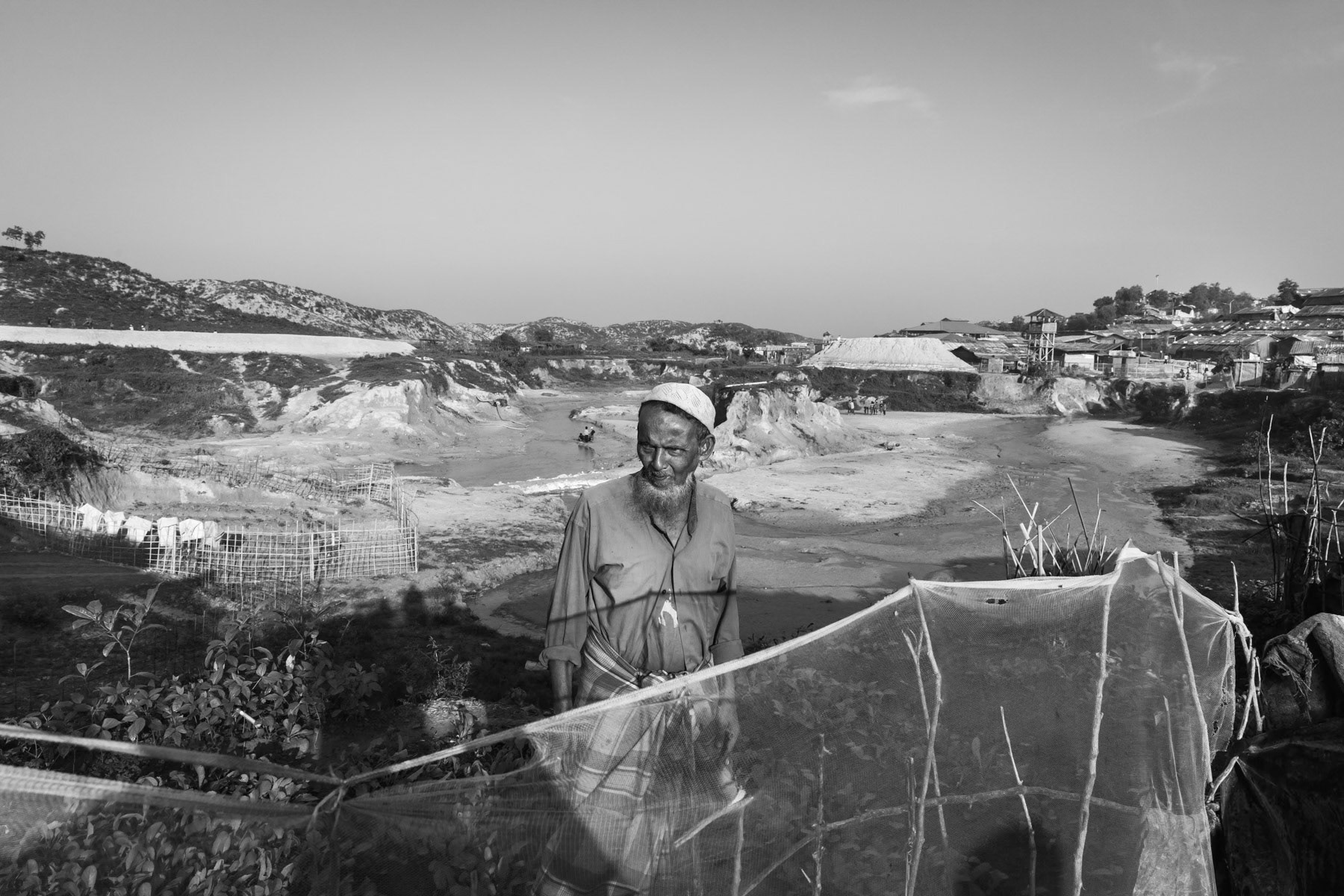
A Rohingya refugee in his small vegetable garden. Over a million refugees from Myanmar populate the camps of Southern Bangladesh. Empty spaces within the camps are extremely rare and having the possibility to grow vegetables is rather exceptional. Thangkhali refugee camp, October 2018
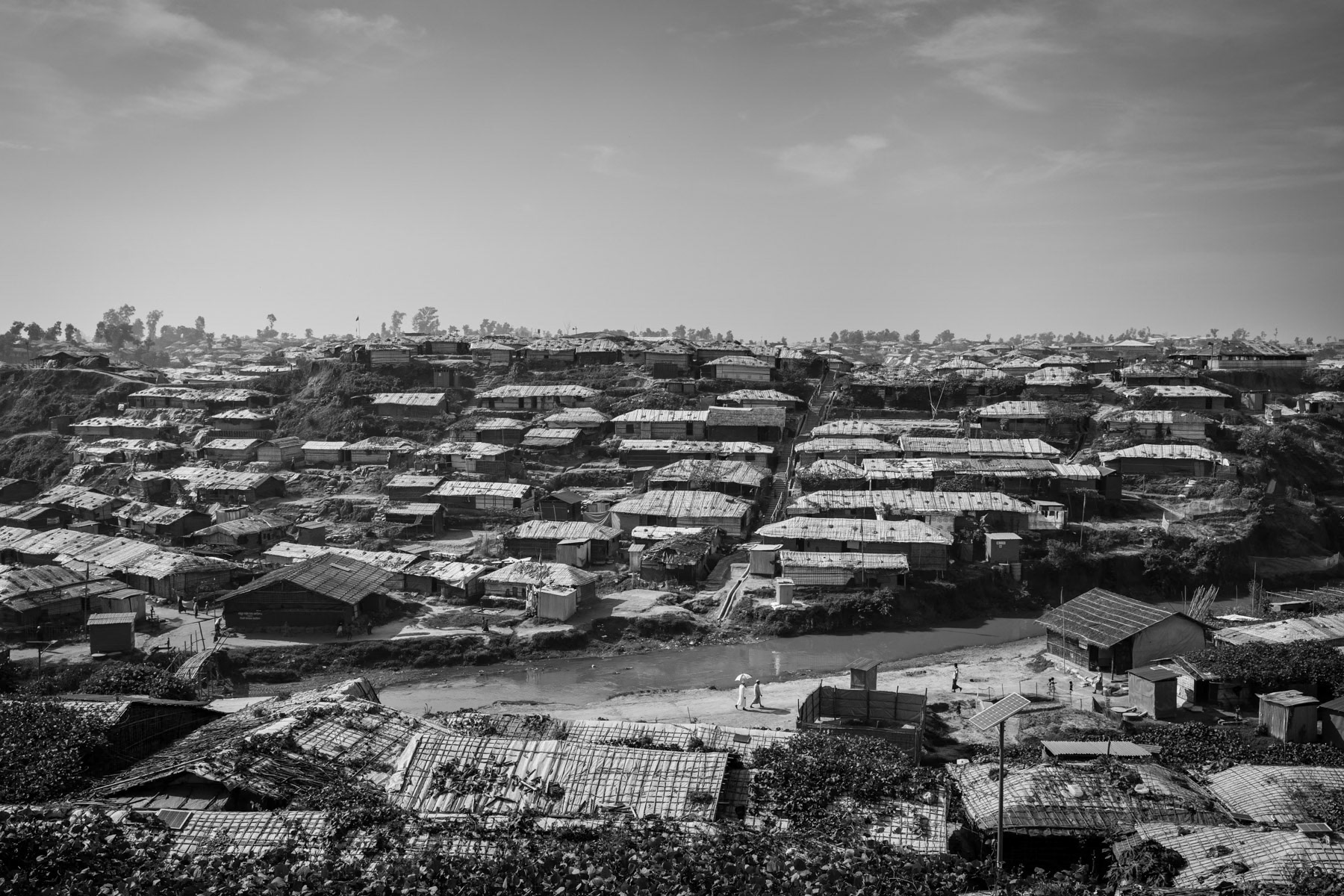
New makeshift blocks for Rohingya refugees from Myanmar. Over three quarter of a million refugees have fled persecution in neighbouring Myanmar since October 2016. Kutupalong refugee camp, Bangladesh, October 2018
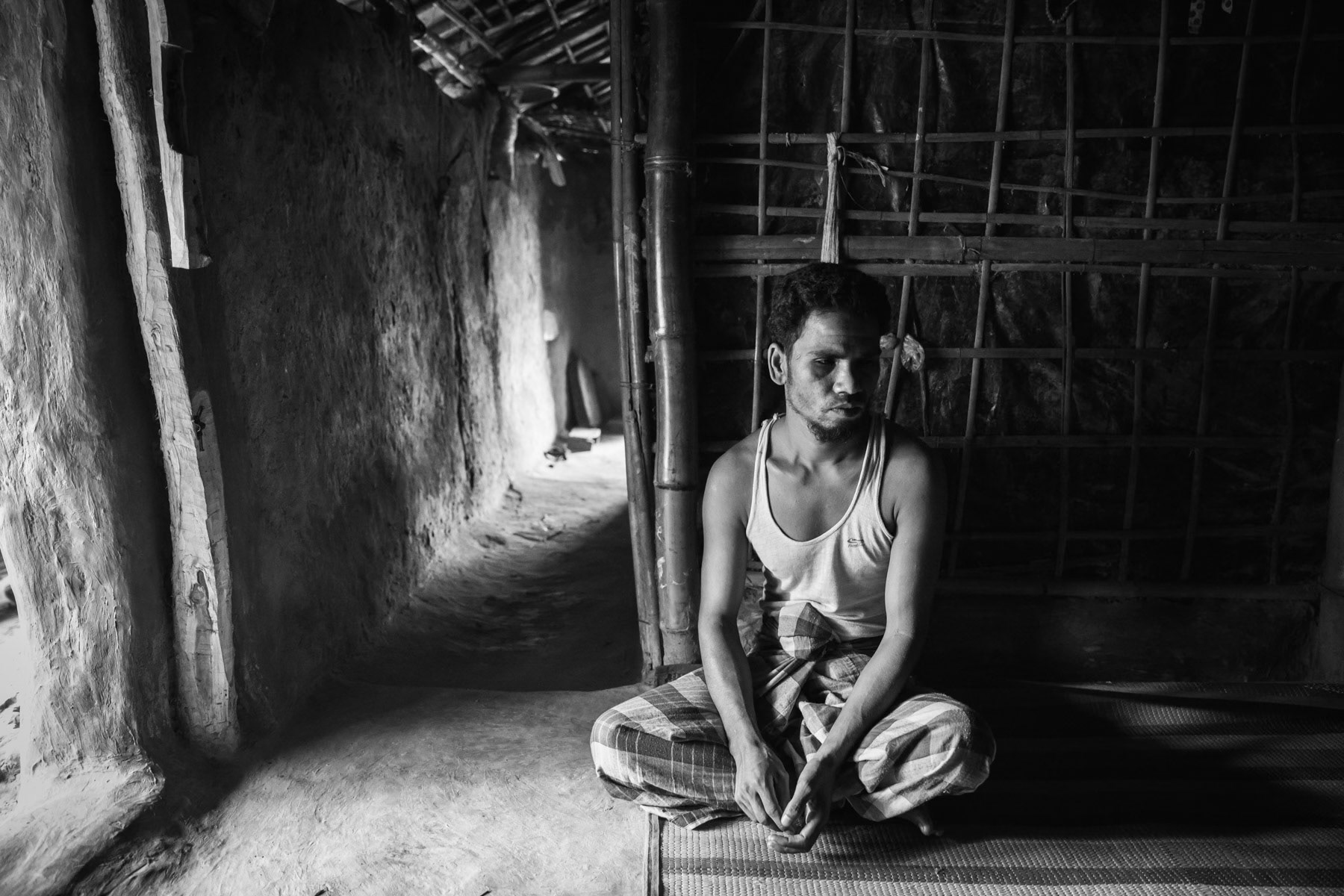
Md. Sultan, 30 years from Maungdaw in Myanmar. His village was attacked by the Myanmar military using mortar shells. He was hit by shrapnel that went through his head behind the eyes. He is now blind and needs 24 hours assistance. His brother died during the same mortar attack. It took him 3 days, with the help of his wife and 2 children, to reach Bangladesh. Kutupalong Rohingya refugee camp, Bangladesh, October 2018

Subiya Khatun's son, one of her surviving children from Chut Pyin near Rathedaung. Subiya is 35 years, her daughter of 15 was raped and consequently killed during the attack on their village by Myanmar military and local Rakhine mobs. Her husband was decapitated and 2 sons of 12 and 13 years were also killed in cold blood. She has one son who fled to Malaysia by boat in 2015 when he was 16 years. She hasn't received any phone call from him since March 2017 and has lost all track of him. Subiya is living with her 4 surviving young children in Bangladesh since Septamber 2017. Thangkhali Rohingya refugee camp in Bangladesh, October 2018
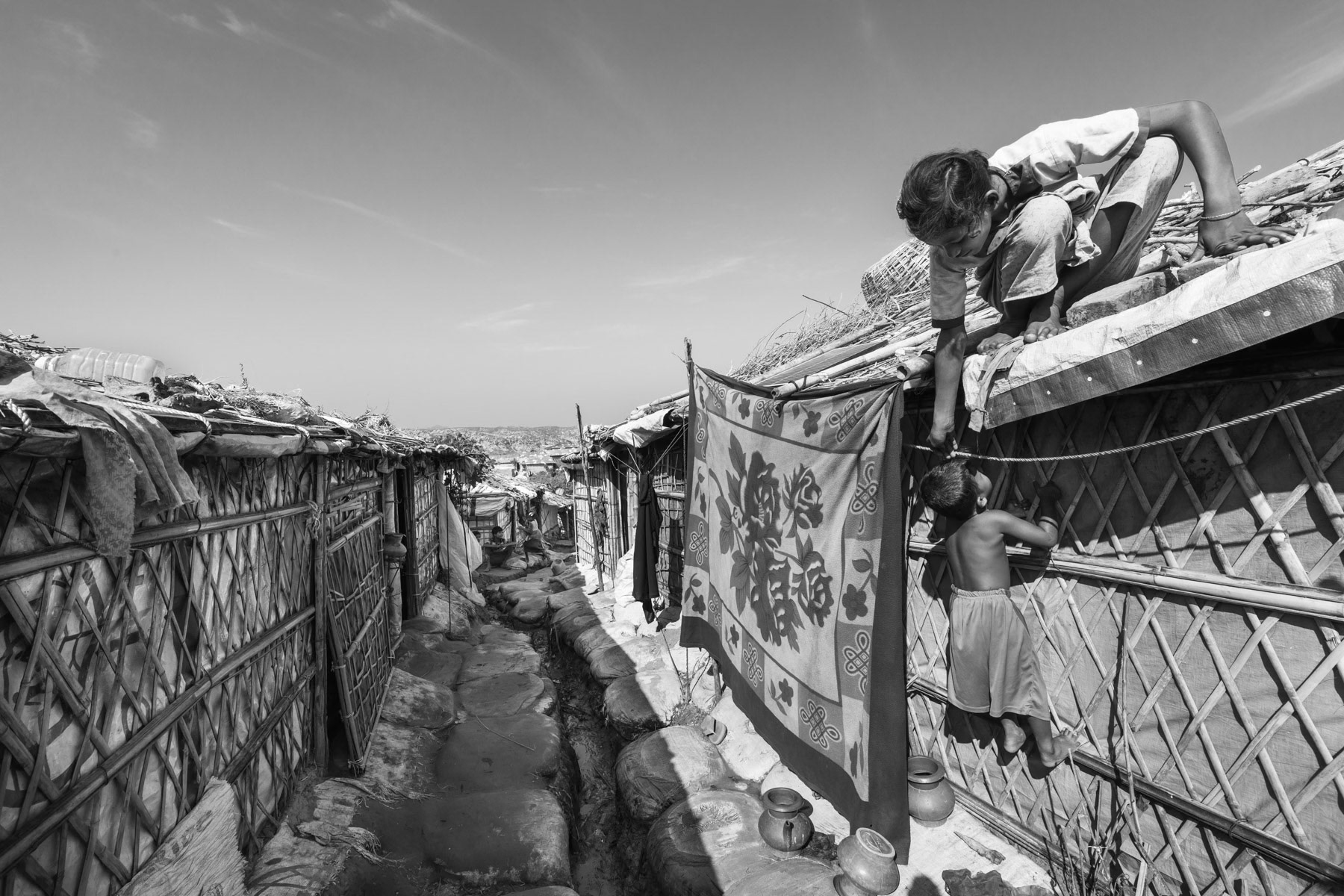
Thangkhali refugee camp for newly arrived Rohingya, nearly one million Rohingya have fled persecution and brutal ethnic cleansing campaigns carried out by the military since October 2016. Ukhiya, Bangladesh, October 2018
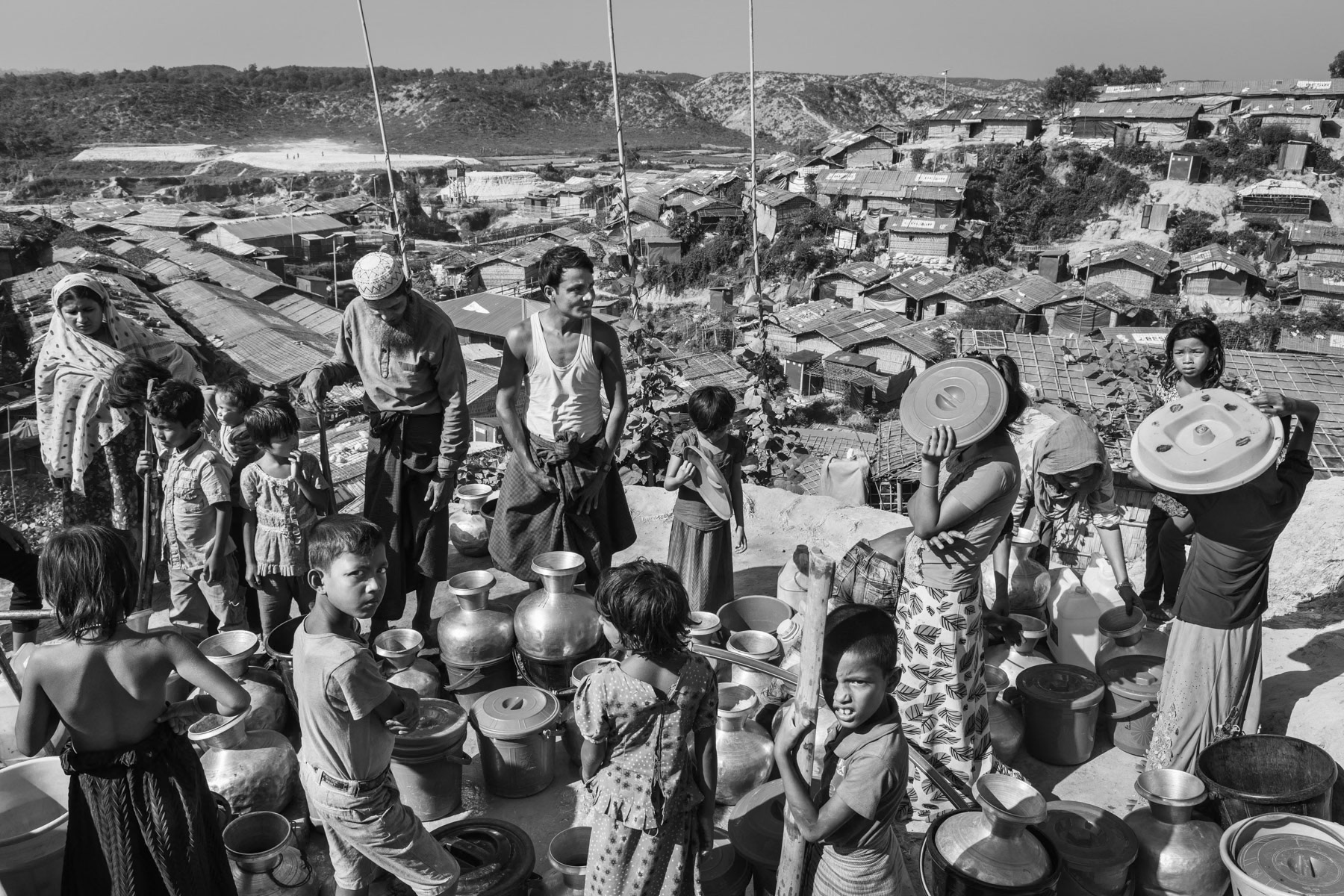
Children and adults waiting for water. Due to an overcrowded situation in the camps and shortage of available water, refugees have to wait long hours before tapping water. The shortage brings tensions and increases the risk of sanitary and health problems. Thangkhali refugee camp for Rohingya in Bangladesh, October 2018
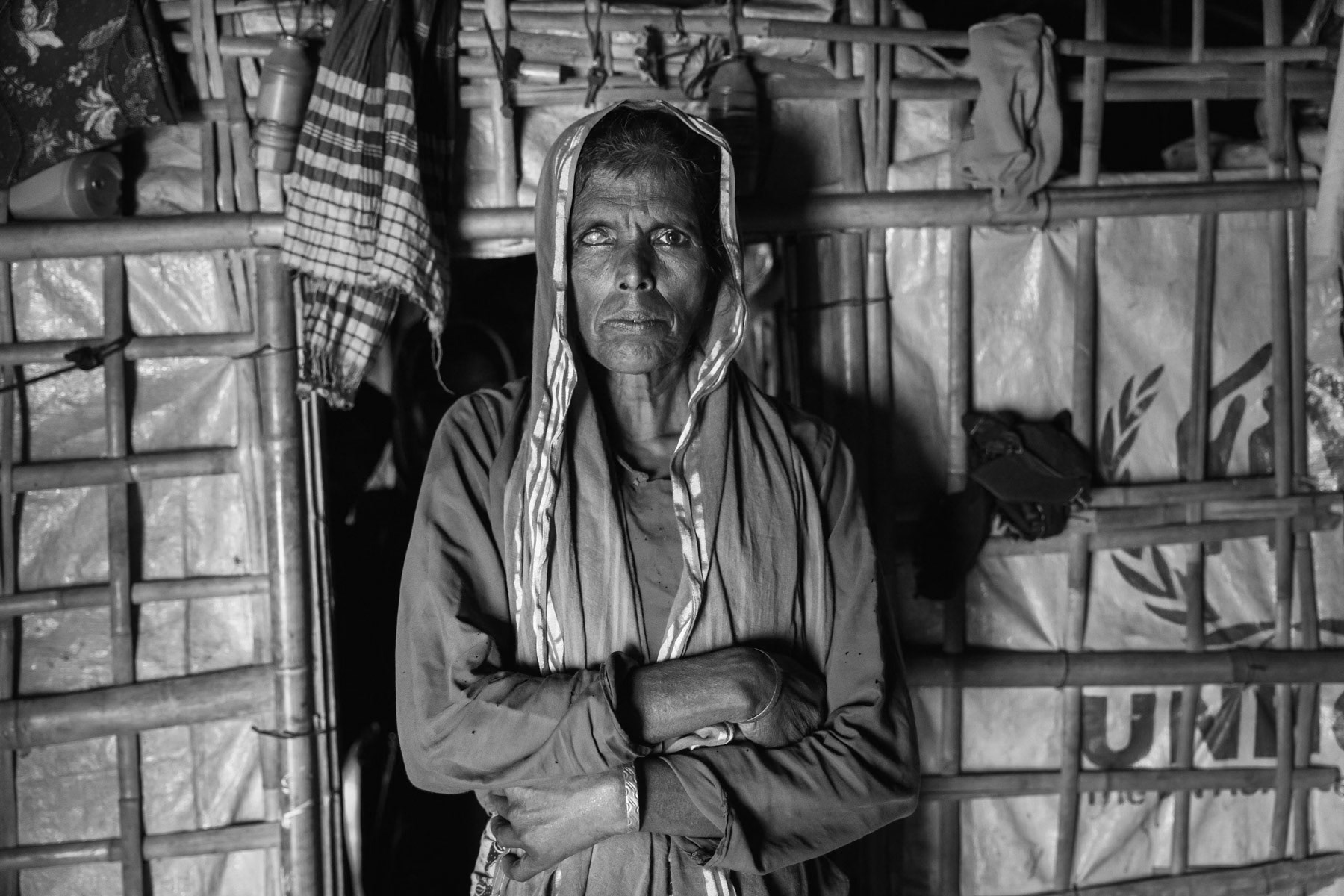
Mahada Khatun, 50 years old Rohingya refugee from Burma. She got injured to one eye by a branch while escaping through the jungle. She has lost sight on that eye. Kutupalong refugee camp, Bangladesh, October 2018
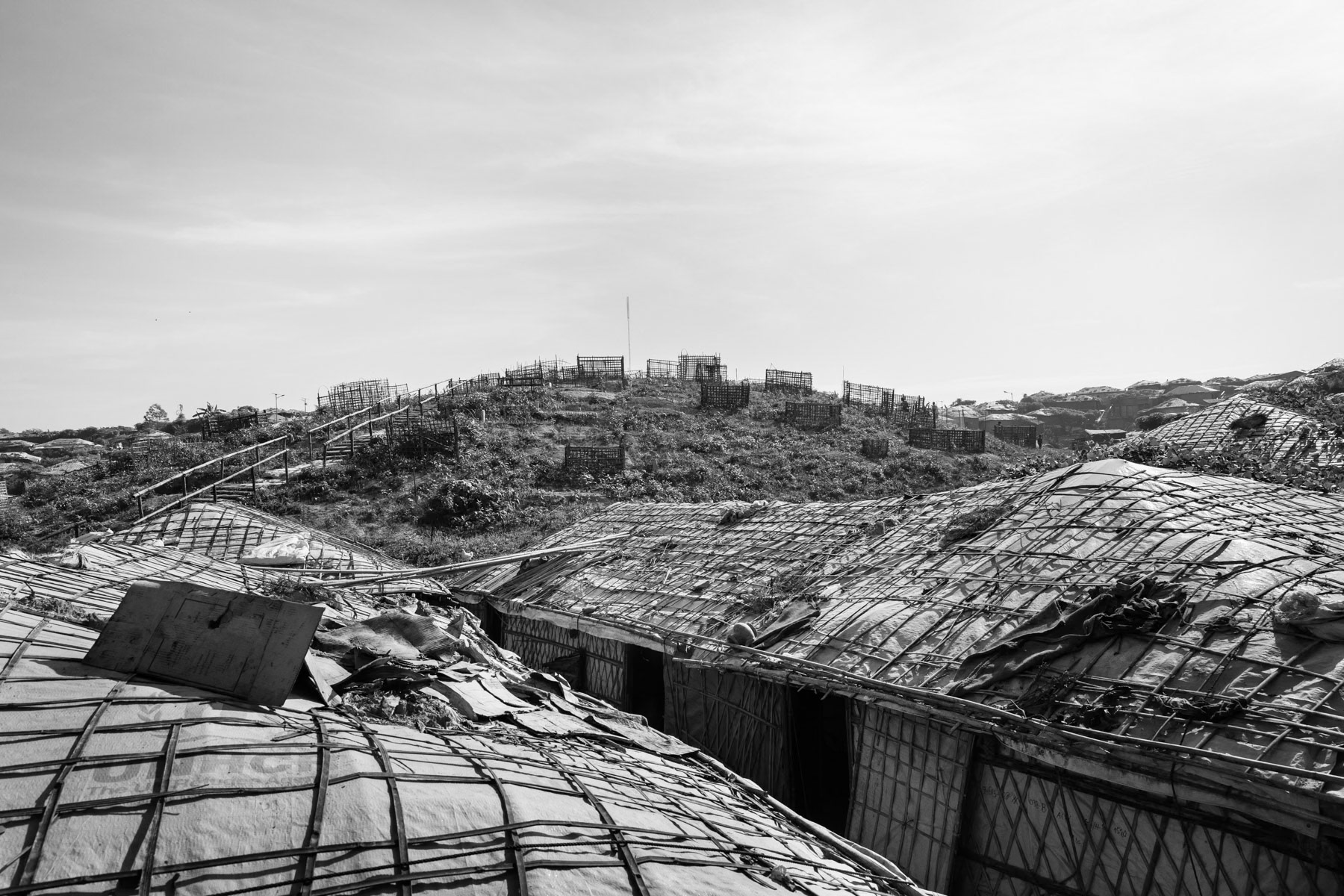
Rohingya graveyard in between the accomodation blocks sheltering the more than 650,000 refugees that have fled Myanmar since August 2017. Kutupalong camp section II, Cox's Bazar, Bangladesh, October 2018
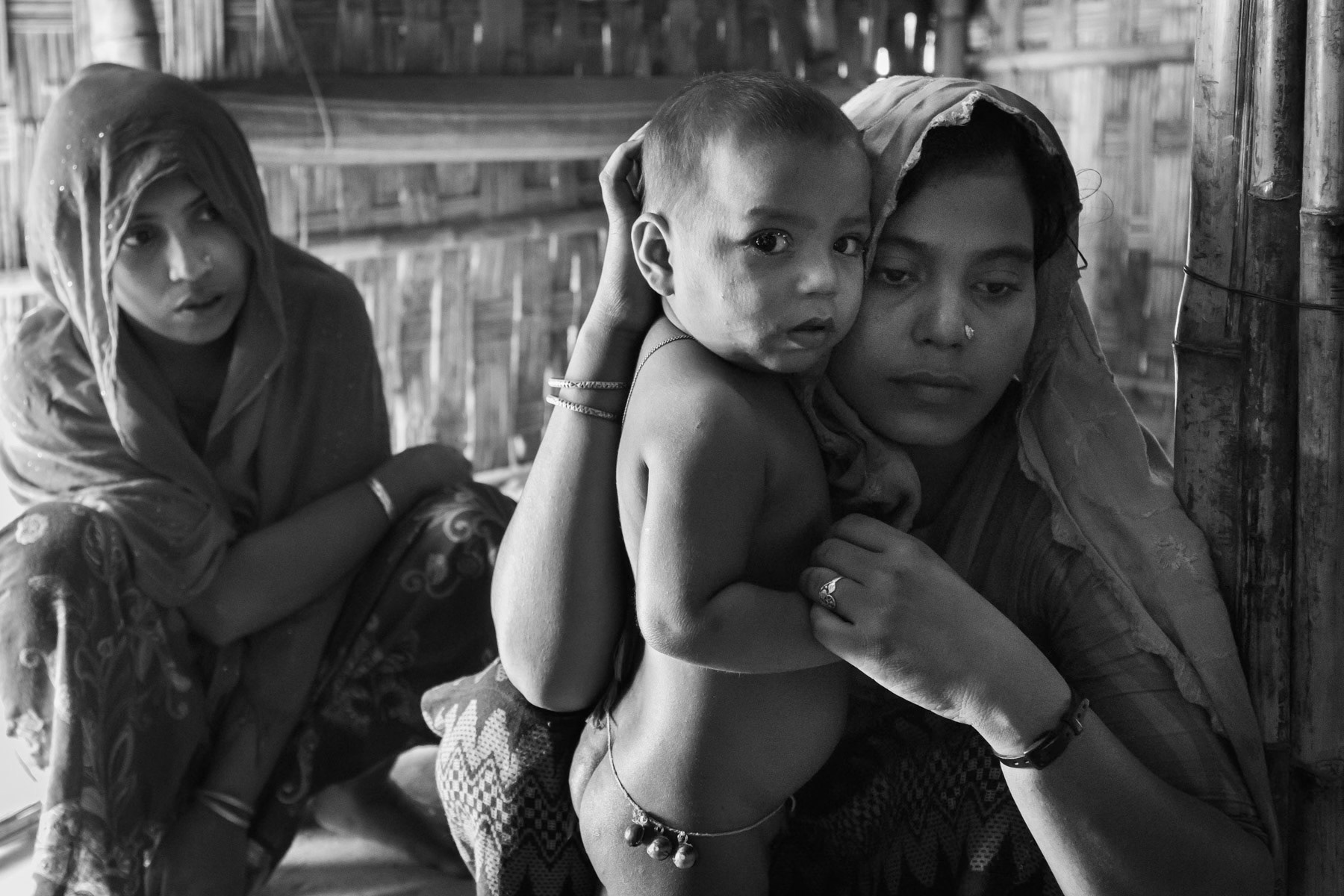
Women of Chut Pyin near Rathedaung in Myanmar and survivors of one of the biggest massacre during the August 2017 onslaught on the Rohingya population of Rakhine. The village has been entirely wiped out, large scale mass rape and executions have taken place, carried out by local Rakhine mobs supported by the regular Myanmar army. Thangkhali refugee camp in Bangladesh, October 2018

Rohingya kids playing ball in Thangkhali refugee camp, Bangladesh, October 2018

Hazera Khatun, 25 years, from Tham Bazar in Buthidaung township, Myanmar. She was wounded by mortar shrapnel in her right leg while fleeing the attack on her village in August 2017. She was carried to Bangladesh for 5 days before getting medical attention. She had metal bolts inserted at the level of her hip at Chittagong general hospital. The bolts and metal rods should have been removed after 6 months but she was told it could not be done without major damage. She has now the utmost difficulties to walk or sit and moving inside the camp is impossible without help. She lives with her husband and 2 children. Her parents, brother and sister are still in Myanmar but they havent had any contact since August 2017 and she doesnt know if they are still alive. Thangkhali camp for Rohingya refugees, Bangladesh, October 2018
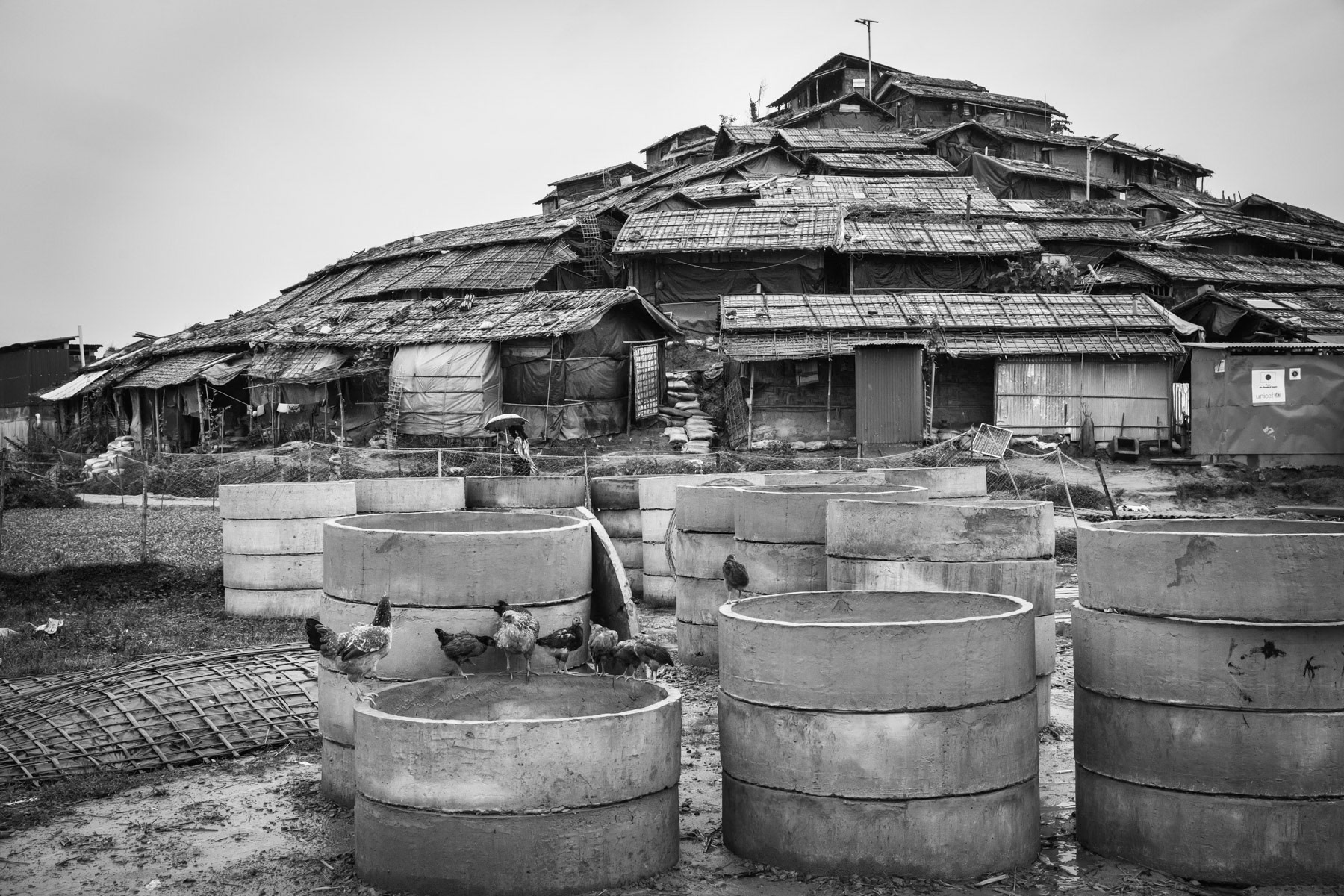
Additional makeshift shelters for the reception of newly arrived Rohingya refugees from Myanmar. More than ¾ of a million Rohingya have fled ethnic cleansing and genocide from neighbouring Myanmar. Jamtoli refugee camp in Southern Bangladesh, October 2018

Recently arrived Rohingya refugee children watching kites fly.More than 650,000 Rohingya refugees have fled persecution since August 2017.The refugee camps in Bangladesh are now sheltering Rohingya victims of the 1978, 1992, 2008, 2012, 2016 and 2017 ethnic cleansing campaigns. By the end of 2018 more than one million Rohingya refugees live in the camps near Cox's Bazar, making it the largest refugee camps in the world. Thangkhali section, Ukhiya, Bangladesh, October 2018
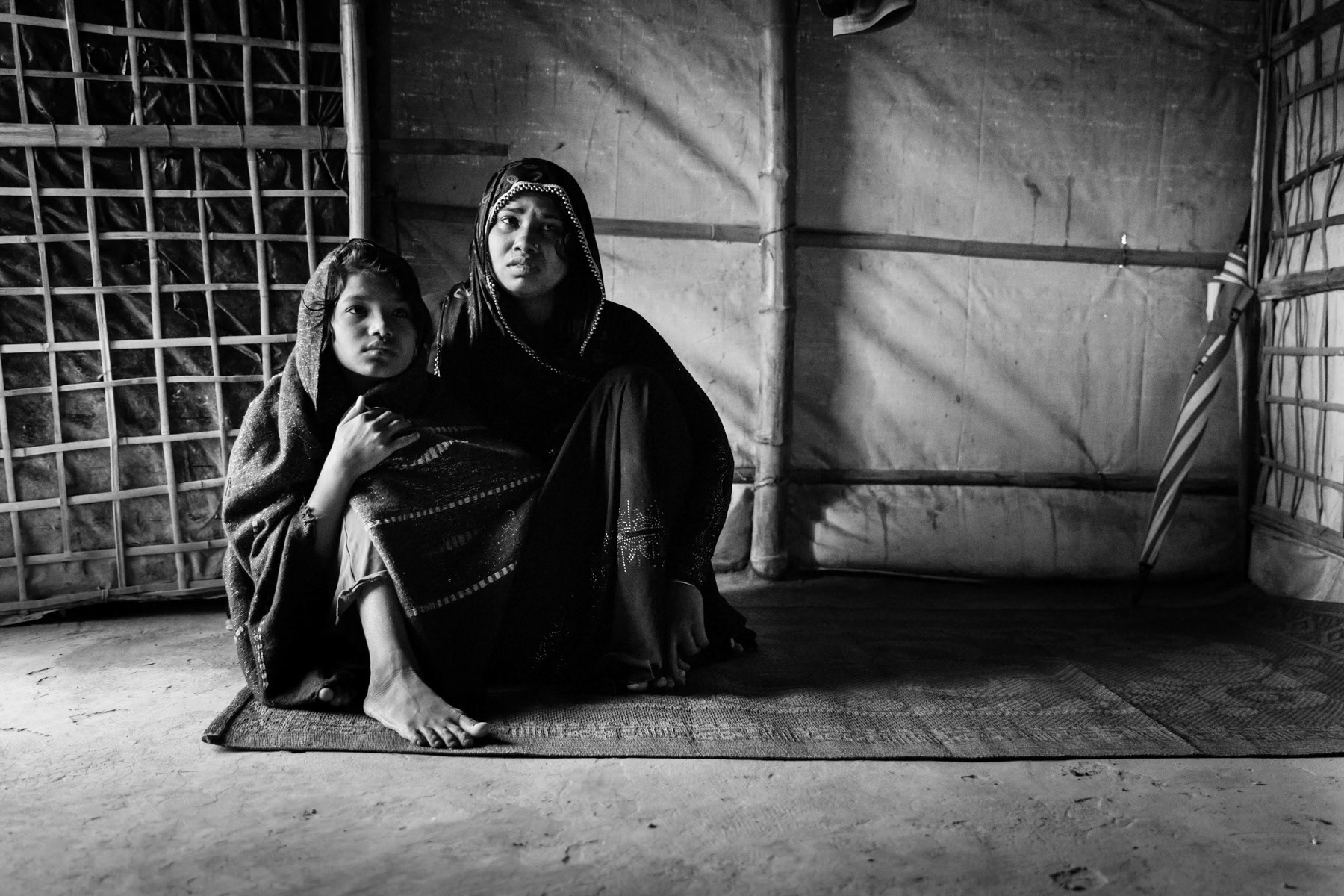
Dildar Begum, 30, and her daughter Nur Kolima, 10, from Tula Toli in Maungdaw township. Her entire family was massacred (decapitated) in fromt of her. Her husband, 2 sons, and one daughter. She and her daughter Nur are the sole survivors. She was gang raped at her house by military and local rakhine. Her surviving daughter, Nur, has been assaulted with a machette and left for dead. After being raped Dildar was also assualted by machette and left for dead, their house with all corpses were set on fire. She managed to escapre through the back with Nur. They fled alone for 5 days through the jungle both badly injured and losing a lot of blood. Having no food, they were feeding themselves with leaves. They finally reached Bangladesh and were transferred to Chittagong hospital where they had blood transfusions. They have been in the refugee camps since October 2017. Her daughter Nur has recognized one of the assaillants as A.S. (Aung Shingha), a Rakhine of a neighbouring village. Nur goes nowadays to school in the camps where she learns English, Burmese and mathematics. Hakimpare camp for Rohingya refugees, Bangladesh, October 2018
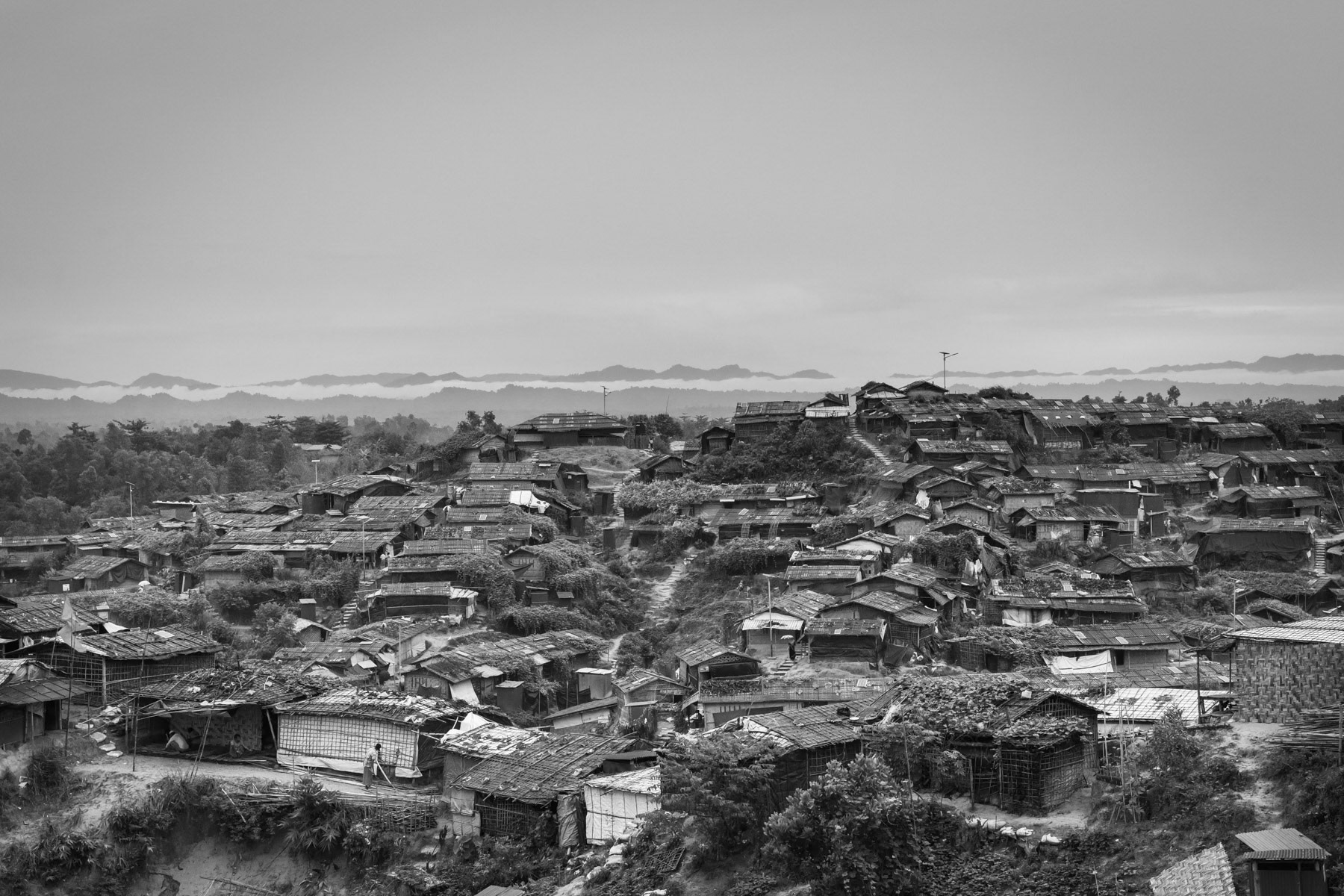
Jamtoli refugee camp with the mountains of Myamnar in the background. More than ¾ of a million Rohingya have fled ethnic cleansing and genocide from neighbouring Myanmar. Southern Bangladesh, October 2018

New makeshift blocks for Rohingya refugees from Myanmar. Over three quarter of a million refugees have fled persecution in neighbouring Myanmar since October 2016. Kutupalong refugee camp, Bangladesh, October 2018
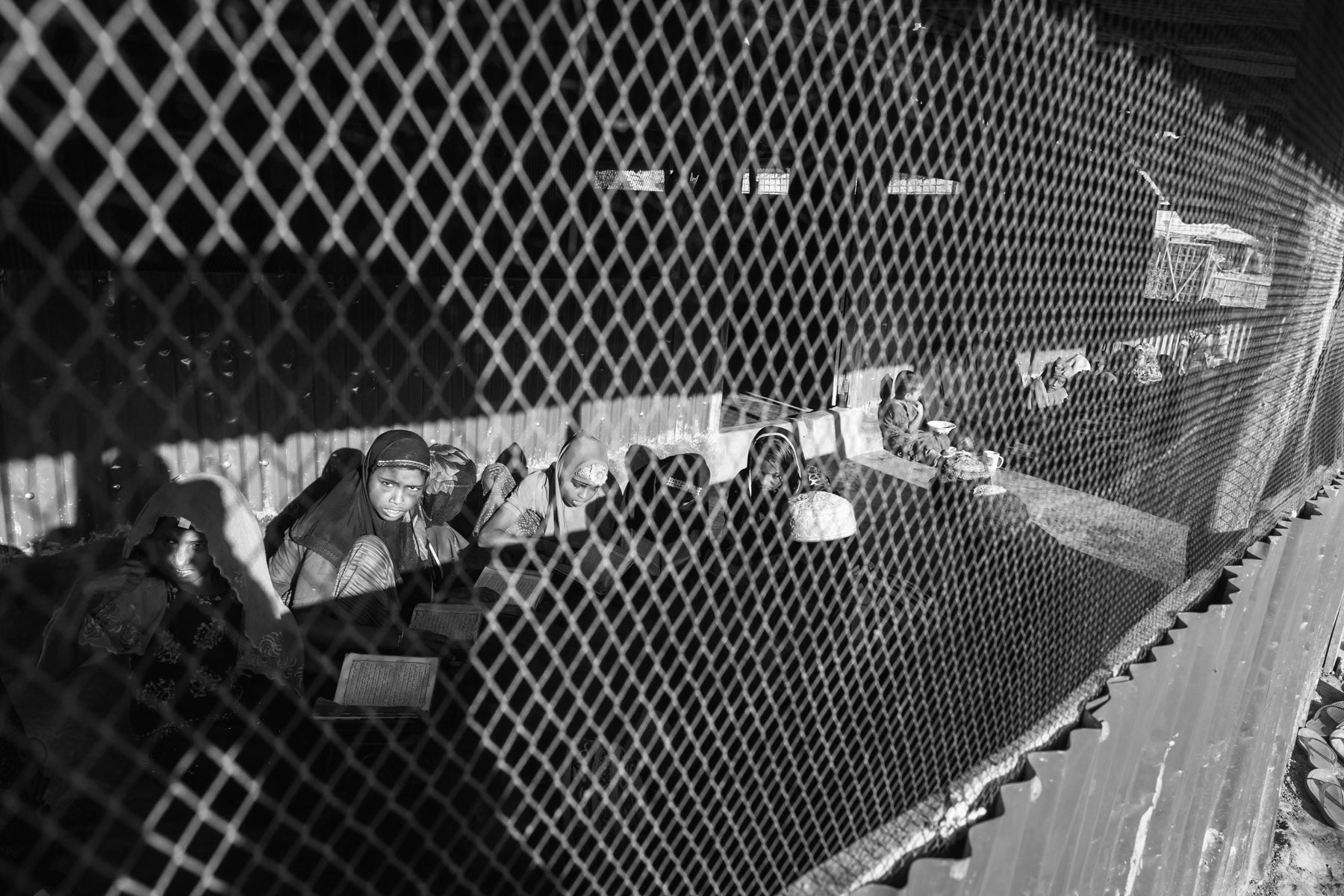
Medressa in the camps where Rohingya children attend religious classes during the early morning hours. Rohingya refugee camp Kutupalong Section II, Bangladesh, October 2018
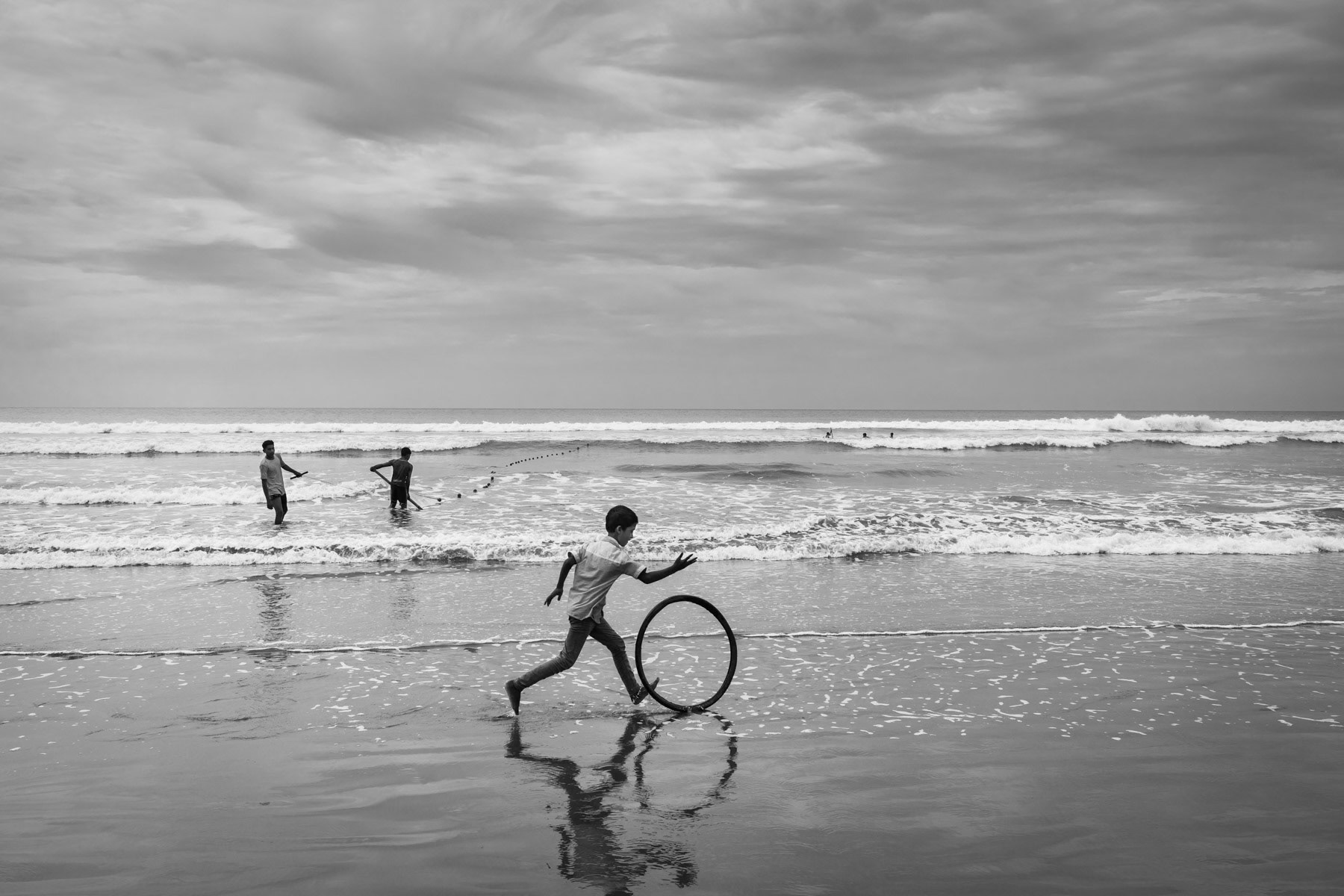
Shamplapur beach from where Rohingya fishermen use to fish, but also an occasional launch point for human traffickers. Bangladesh, October 2018
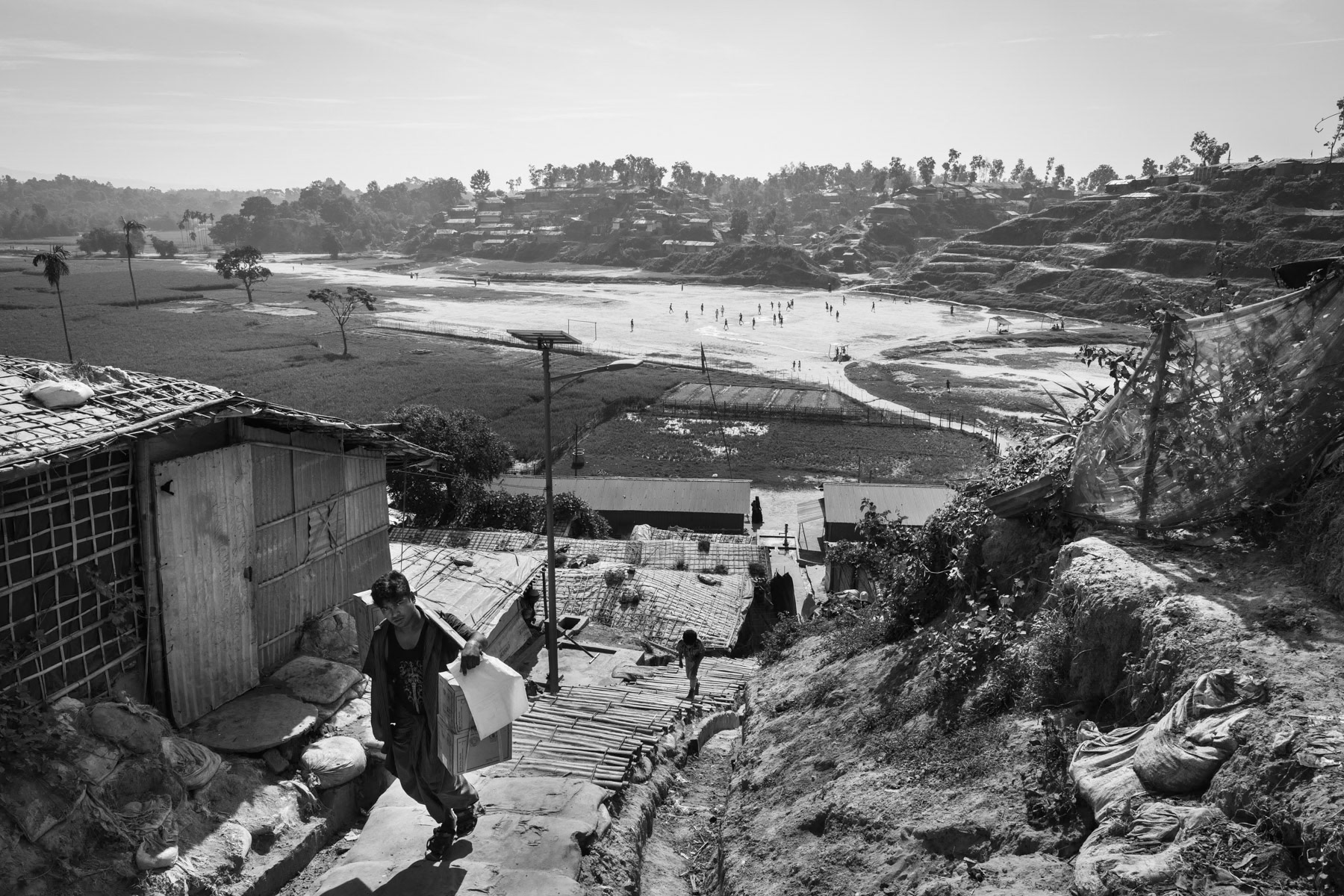
A new extension to the already overcrowded refugee camps to shelter part of the 650,000 newly arrived Rohingya refugees. The Rohingya refugee camps are now sheltering Rohingya victims of the 1978, 1992, 2008, 2012, 2016 and 2017 ethnic cleansing campaigns. By end 2018 more than one million Rohingya refugees live in the camps near Cox's Bazar making it the largest refugee camps in the world. Kutupalong section II, Ukhiya, Bangladesh, October 2018

New makeshift blocks for Rohingya refugees from Myanmar. Over three quarter of a million refugees have fled persecution in neighbouring Myanmar since October 2016. Hakimpara refugee camp, Bangladesh, October 2018

Moria Khatun and her new born son is from Maungdaw township in Myanmar and a victim of sexual abuse. She was tortured, blindfolded, tightened and gang raped for 4 hours by military and local Rakhine. After the military left the village, her husband who was hiding in the jungle, came to evacuate her. Nuru Hafez the little baby boy was born in June 2018 nine months after she had been raped. Balukhali refugee camp in Bangladesh, October 2018
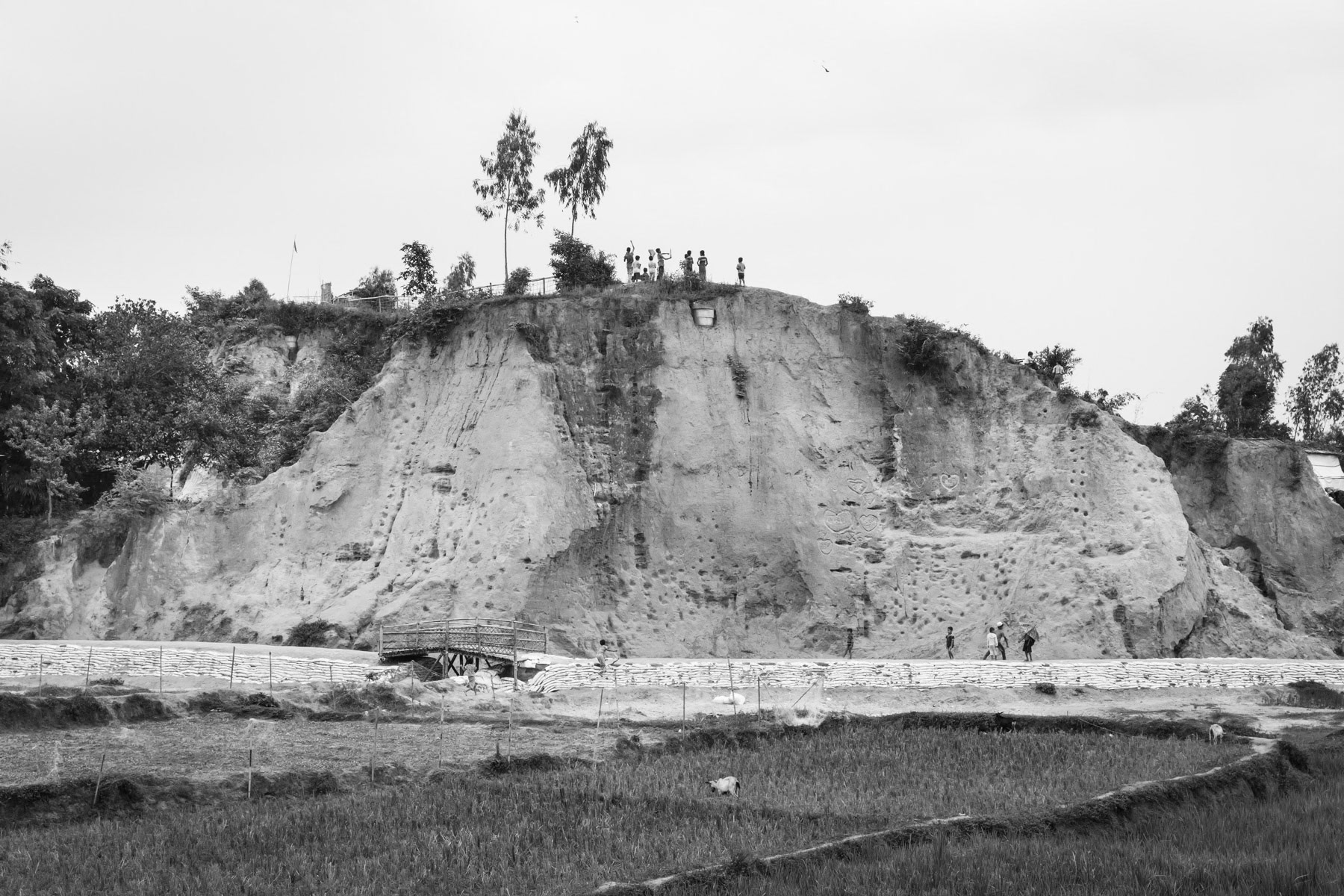
Rohingya children catching wind with their kites on top of a hill. Thangkhali refugee camp, Bangladesh, October 2018
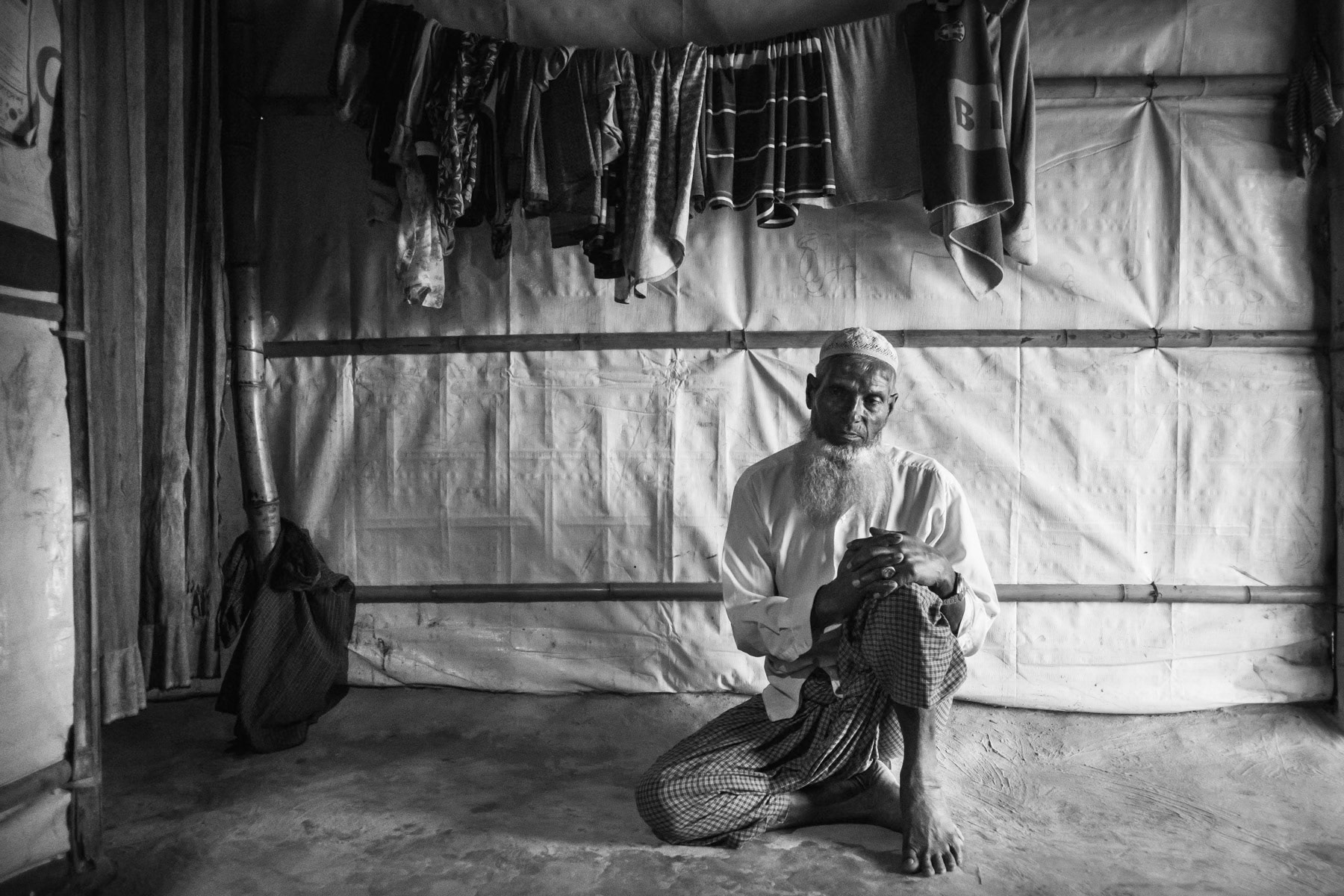
Hanifa, 60 years, a Rohingya refugee from Maungdaw township. worked all his life as a farmer untill his village was attacked by the Burmese military in August 2017. He was hit by mortar shrapnel during the attack but managed to escape with his wife and 3 children. They all live safely in the refugee camps along the border. Thangkhali refugee camp, Bangladesh, October 2018

A new extension to the already overcrowded refugee camps to shelter part of the 650,000 newly arrived Rohingya refugees. The Rohingya refugee camps are now sheltering Rohingya victims of the 1978, 1992, 2008, 2012, 2016 and 2017 ethnic cleansing campaigns. By end 2018 more than one million Rohingya refugees live in the camps near Cox's Bazar making it the largest refugee camps in the world. Balukhali section, Ukhiya, Bangladesh, October 2018
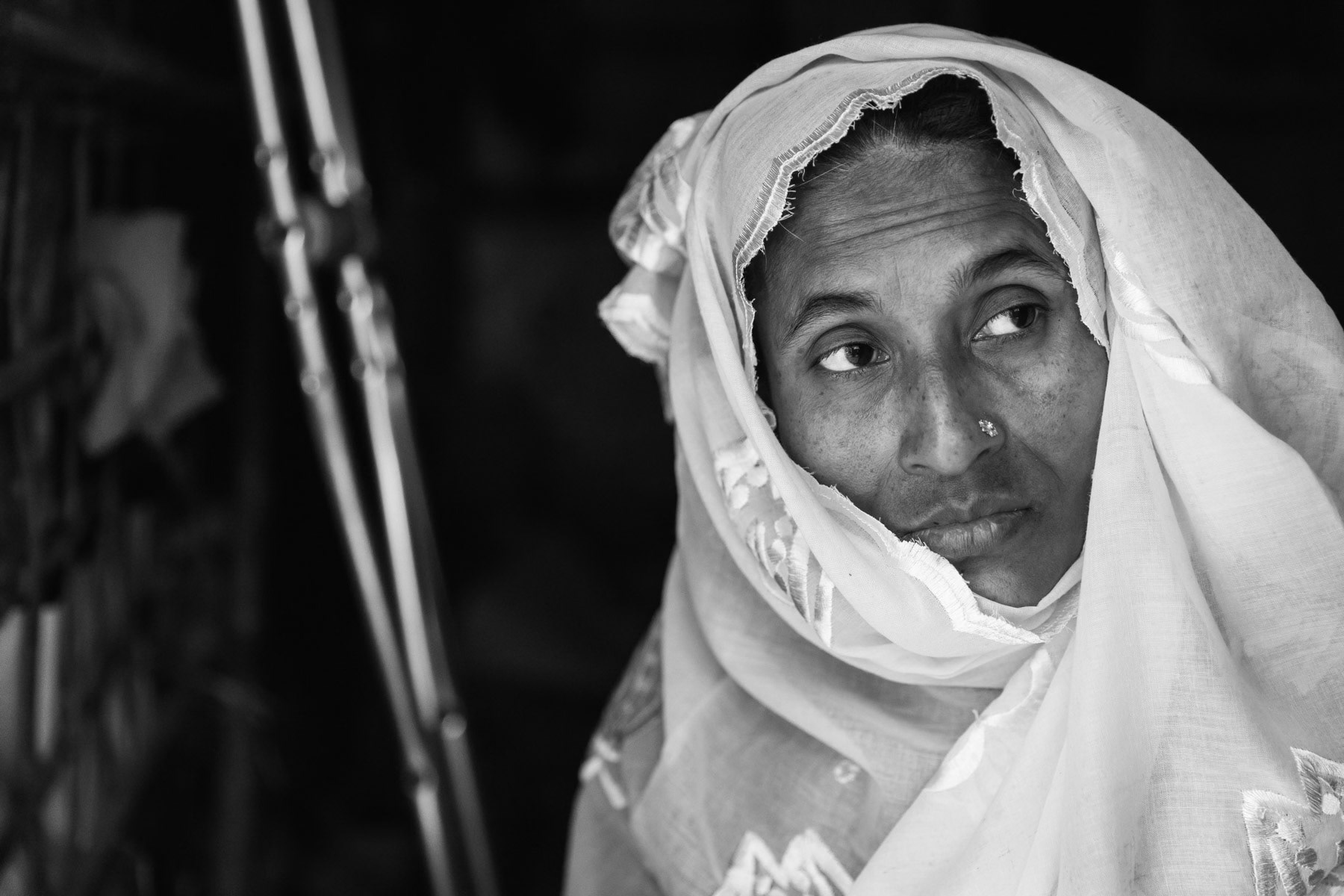
Fatima Begum, 38 years from Maungdaw township. She fled her village with her husband and children. One son of 2 years old felt in a pond while escaping and drowned. She was shot in the leg and after 5 days without any medical attention she was brought to the Chittagong general hospital where her leg was so badly infected that it had to be amputated. She lives now in Thangkhali refugee camp with her husband and two children. Cox's bazar, Bangladesh, October 2018
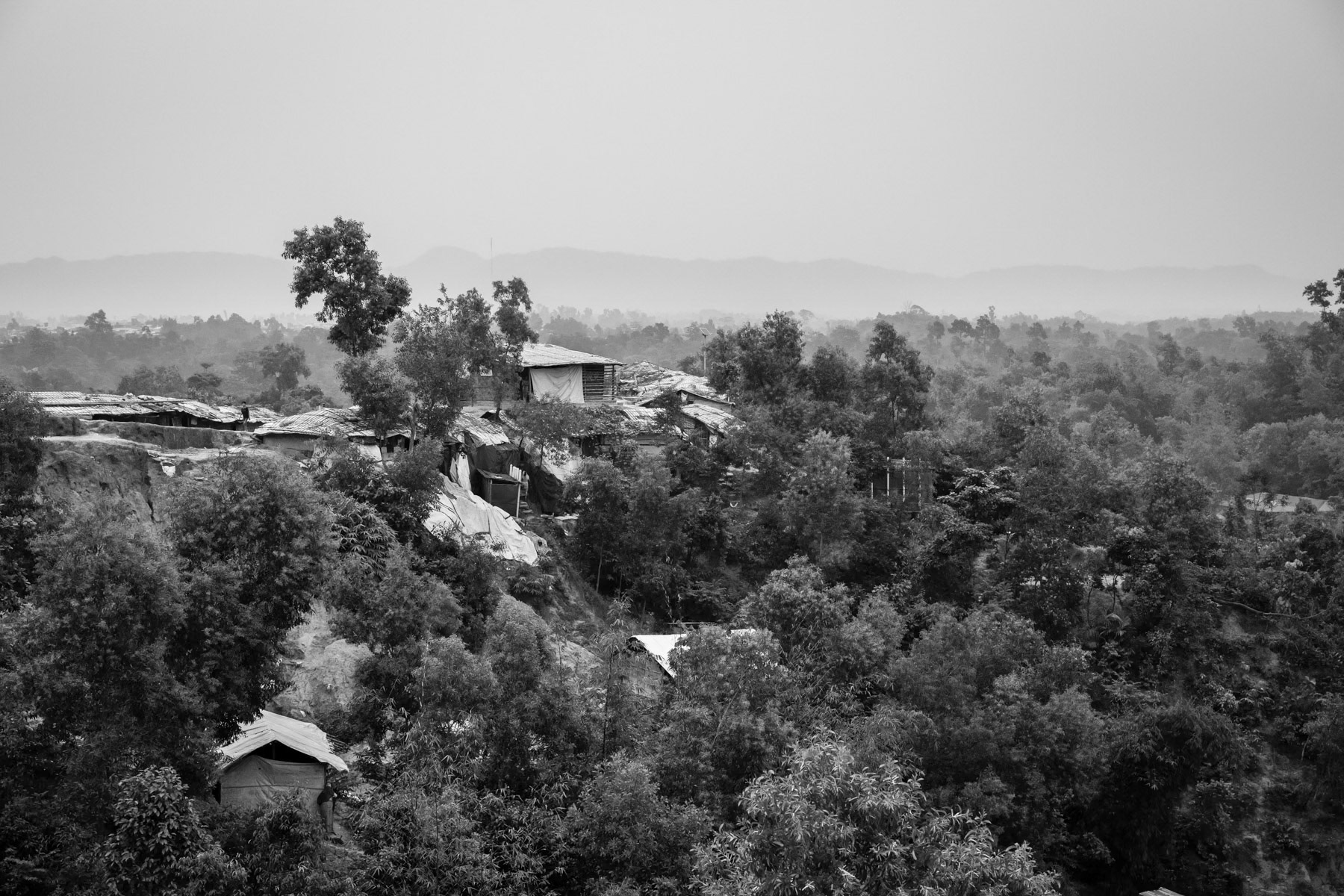
Hakimpara refugee camp with the mountains of Myamnar in the background. More than ¾ of a million Rohingya have fled ethnic cleansing and genocide from neighbouring Myanmar. Southern Bangladesh, October 2018
